Netgear orporated 10300143 Wireless Cable Modem Gateway User Manual
Netgear Incorporated Wireless Cable Modem Gateway
User Manual

350 East Plumeria Drive
San Jose, CA 95134
USA
January 2011
202-10773-01
v1.0
Wireless Cable Modem
Gateway CG2003D
User Manual

2 |
Wireless Cable Modem Gateway CG2003D User Manual
©2011 NETGEAR, Inc. All rights reserved.
No part of this publication may be reproduced, transmitted, transcribed, stored in a retrieval system, or translated
into any language in any form or by any means without the written permission of NETGEAR, Inc.
Technical Support
Thank you for choosing NETGEAR. To register your product, get the latest product updates, or get support online,
visit us at http://support.netgear.com.
Phone (US & Canada only): 1-888-NETGEAR
Phone (Other Countries): See Support information card.
Trademarks
NETGEAR, the NETGEAR logo, ReadyNAS, ProSafe, Smart Wizard, Auto Uplink, X-RAID2, and NeoTV are
trademarks or registered trademarks of NETGEAR, Inc. Microsoft, Windows, Windows NT, and Vista are
registered trademarks of Microsoft Corporation. Other brand and product names are registered trademarks or
trademarks of their respective holders.
Statement of Conditions
To improve internal design, operational function, and/or reliability, NETGEAR reserves the right to make changes
to the products described in this document without notice. NETGEAR does not assume any liability that may occur
due to the use, or application of, the product(s) or circuit layout(s) described herein.

Contents | 3
Contents
Chapter 1 Connecting the Gateway to the Internet
Unpack your Gateway . . . . . . . . . . . . . . . . . . . . . . . . . . . . . . . . . . . . . . . . .5
Gateway Stand. . . . . . . . . . . . . . . . . . . . . . . . . . . . . . . . . . . . . . . . . . . . . . .5
Front Panel . . . . . . . . . . . . . . . . . . . . . . . . . . . . . . . . . . . . . . . . . . . . . . . . 6
Rear Panel . . . . . . . . . . . . . . . . . . . . . . . . . . . . . . . . . . . . . . . . . . . . . . . .7
Label. . . . . . . . . . . . . . . . . . . . . . . . . . . . . . . . . . . . . . . . . . . . . . . . . . . . .7
What You Need Before You Begin. . . . . . . . . . . . . . . . . . . . . . . . . . . . . . . .7
Cabling the Gateway . . . . . . . . . . . . . . . . . . . . . . . . . . . . . . . . . . . . . . . . . .8
Log in to the Gateway. . . . . . . . . . . . . . . . . . . . . . . . . . . . . . . . . . . . . . . . . .9
Basic Cable Network Settings . . . . . . . . . . . . . . . . . . . . . . . . . . . . . . . . . .10
Chapter 2 Wireless Settings
Wireless Adapter Compatibility. . . . . . . . . . . . . . . . . . . . . . . . . . . . . . . . . .11
Security Basics. . . . . . . . . . . . . . . . . . . . . . . . . . . . . . . . . . . . . . . . . . . . . .12
Disable SSID Broadcast . . . . . . . . . . . . . . . . . . . . . . . . . . . . . . . . . . . . .12
Restrict Access by MAC Address. . . . . . . . . . . . . . . . . . . . . . . . . . . . . .12
Wireless Security Options . . . . . . . . . . . . . . . . . . . . . . . . . . . . . . . . . . .12
Add Clients (Computers or Devices) to Your Network . . . . . . . . . . . . . . . .13
Manual Method. . . . . . . . . . . . . . . . . . . . . . . . . . . . . . . . . . . . . . . . . . . .13
Wi-Fi Protected Setup (WPS) Method . . . . . . . . . . . . . . . . . . . . . . . . . .13
Wireless Settings Screen . . . . . . . . . . . . . . . . . . . . . . . . . . . . . . . . . . . . . .14
Consider Every Device on Your Network . . . . . . . . . . . . . . . . . . . . . . . .15
View or Change Wireless Settings . . . . . . . . . . . . . . . . . . . . . . . . . . . . .15
Set up Access Control by MAC Address . . . . . . . . . . . . . . . . . . . . . . . .16
Change the WPA Security Option and Pre-Shared Key. . . . . . . . . . . . .18
Set WEP Encryption and Passphrase . . . . . . . . . . . . . . . . . . . . . . . . . .19
Wireless Guest Networks . . . . . . . . . . . . . . . . . . . . . . . . . . . . . . . . . . . . . .20
Wireless Guest Network Screen Fields . . . . . . . . . . . . . . . . . . . . . . . . .21
Set up Wi-Fi Multimedia . . . . . . . . . . . . . . . . . . . . . . . . . . . . . . . . . . . . . . . 21
Chapter 3 Content Filtering and Firewall Rules
Logs . . . . . . . . . . . . . . . . . . . . . . . . . . . . . . . . . . . . . . . . . . . . . . . . . . . . . . 24
Block HTTP Traffic by Keywords or Domains . . . . . . . . . . . . . . . . . . . . . .25
Block Services . . . . . . . . . . . . . . . . . . . . . . . . . . . . . . . . . . . . . . . . . . . . . .26
Port Forwarding and Port Blocking. . . . . . . . . . . . . . . . . . . . . . . . . . . . . . .27
Set Up Port Blocking . . . . . . . . . . . . . . . . . . . . . . . . . . . . . . . . . . . . . . . . . 27
Set Up Port Forwarding . . . . . . . . . . . . . . . . . . . . . . . . . . . . . . . . . . . . . . .28
Set up Port Triggering . . . . . . . . . . . . . . . . . . . . . . . . . . . . . . . . . . . . . . . . 30

4 | Contents
Wireless Cable Modem Gateway CG2003D User Manual
Chapter 4 Managing Your Network
Gateway Status . . . . . . . . . . . . . . . . . . . . . . . . . . . . . . . . . . . . . . . . . . . . . 33
Connection Status . . . . . . . . . . . . . . . . . . . . . . . . . . . . . . . . . . . . . . . . . 34
Change Passwords . . . . . . . . . . . . . . . . . . . . . . . . . . . . . . . . . . . . . . . . . . 34
Reset to Factory Default Settings. . . . . . . . . . . . . . . . . . . . . . . . . . . . . . 35
Back Up and Restore Your Settings. . . . . . . . . . . . . . . . . . . . . . . . . . . . . . 36
Event Log . . . . . . . . . . . . . . . . . . . . . . . . . . . . . . . . . . . . . . . . . . . . . . . . . . 36
Run the Diagnostic Ping Utility . . . . . . . . . . . . . . . . . . . . . . . . . . . . . . . . . . 37
Chapter 5 Advanced Settings
Dynamic DNS. . . . . . . . . . . . . . . . . . . . . . . . . . . . . . . . . . . . . . . . . . . . . . . 40
Set Up a DMZ Host . . . . . . . . . . . . . . . . . . . . . . . . . . . . . . . . . . . . . . . . . . 41
LAN IP Settings . . . . . . . . . . . . . . . . . . . . . . . . . . . . . . . . . . . . . . . . . . . . . 41
Reserve an IP Address for DHCP Use. . . . . . . . . . . . . . . . . . . . . . . . . . 43
Set up Remote Management . . . . . . . . . . . . . . . . . . . . . . . . . . . . . . . . . . .43
Remote Management After a Reset. . . . . . . . . . . . . . . . . . . . . . . . . . . . 44
URL to Connect to The Gateway . . . . . . . . . . . . . . . . . . . . . . . . . . . . . . 44
Universal Plug and Play (UPnP) . . . . . . . . . . . . . . . . . . . . . . . . . . . . . . . .45
Chapter 6 Troubleshooting
Using LEDs to Troubleshoot . . . . . . . . . . . . . . . . . . . . . . . . . . . . . . . . . . .47
Cannot Log in to the Gateway . . . . . . . . . . . . . . . . . . . . . . . . . . . . . . . . . . 48
Troubleshooting the Internet Connection . . . . . . . . . . . . . . . . . . . . . . . . . . 49
Troubleshooting a TCP/IP Network Using a Ping Utility. . . . . . . . . . . . . . . 49
Test the LAN Path to Your Gateway . . . . . . . . . . . . . . . . . . . . . . . . . . . 49
Test the Path from Your PC to a Remote Device. . . . . . . . . . . . . . . . . . 50
Appendix A Technical Specifications and Factory Default Settings
Technical Specifications. . . . . . . . . . . . . . . . . . . . . . . . . . . . . . . . . . . . . . . 51
Factory Default Settings . . . . . . . . . . . . . . . . . . . . . . . . . . . . . . . . . . . . . . . 52
Appendix B Related Documents
Appendix C Notification of Compliance
Index
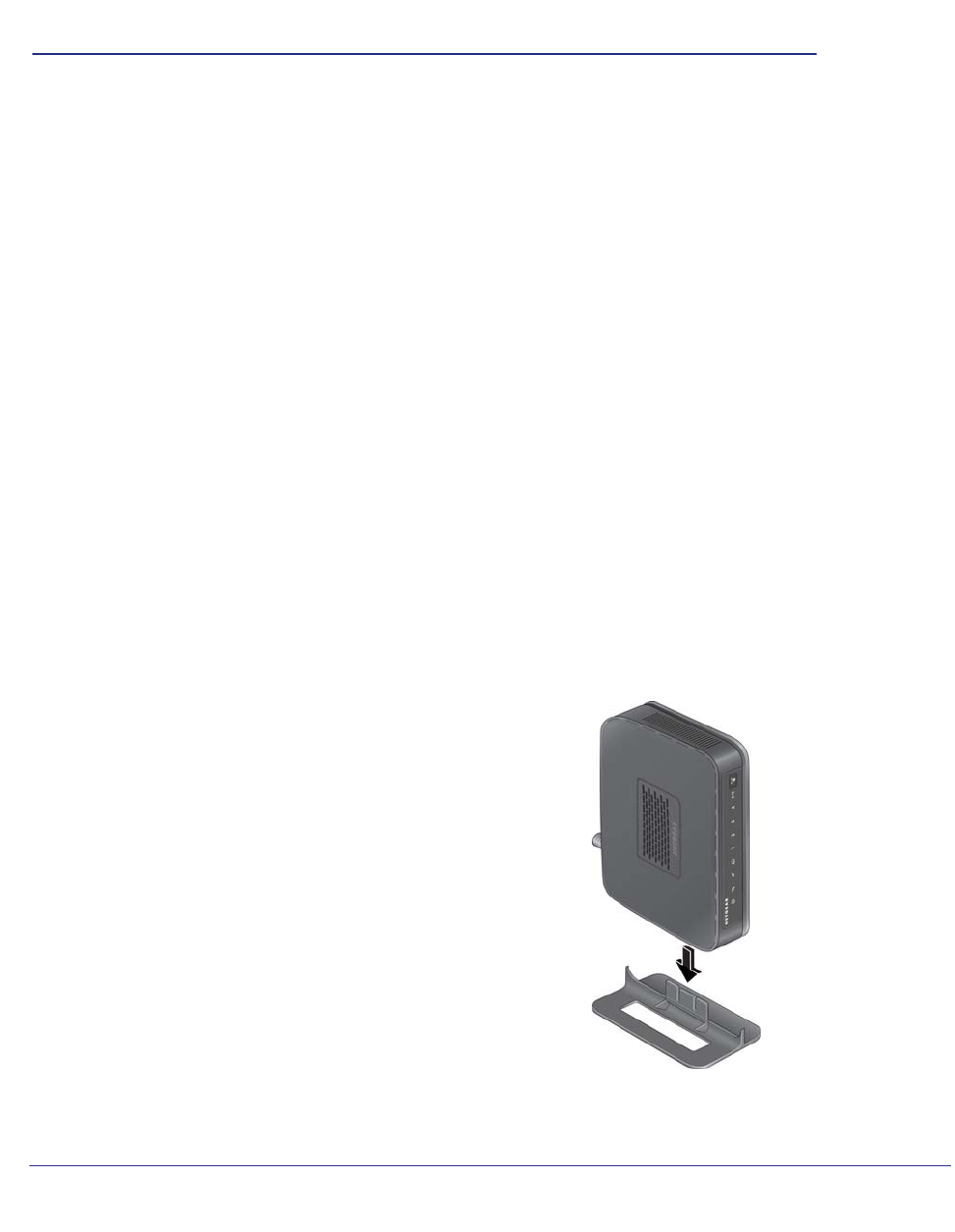
Chapter 1. Connecting the Gateway to the Internet | 5
1
1. Connecting the Gateway to the Internet
This chapter describes how to set up the Wireless Cable Modem Gateway on your Local Area
Network (LAN), connect to the Internet, and perform basic configuration.
Unpack your Gateway
The product package should contain the following items:
• Wireless Cable Modem Gateway CG2003D
• AC power adapter
• Category 5 (CAT5) Ethernet cable
• Stand
If any parts are incorrect, missing, or damaged, contact your NETGEAR dealer. Keep the
carton and original packing materials, in case you need to return the product for repair.
Gateway Stand
You can place the gateway vertically or horizontally.
To place the gateway vertically, attach the stand to
the bottom of the gateway, and place it on a flat
surface, as shown.
Figure 1. Vertical position with stand
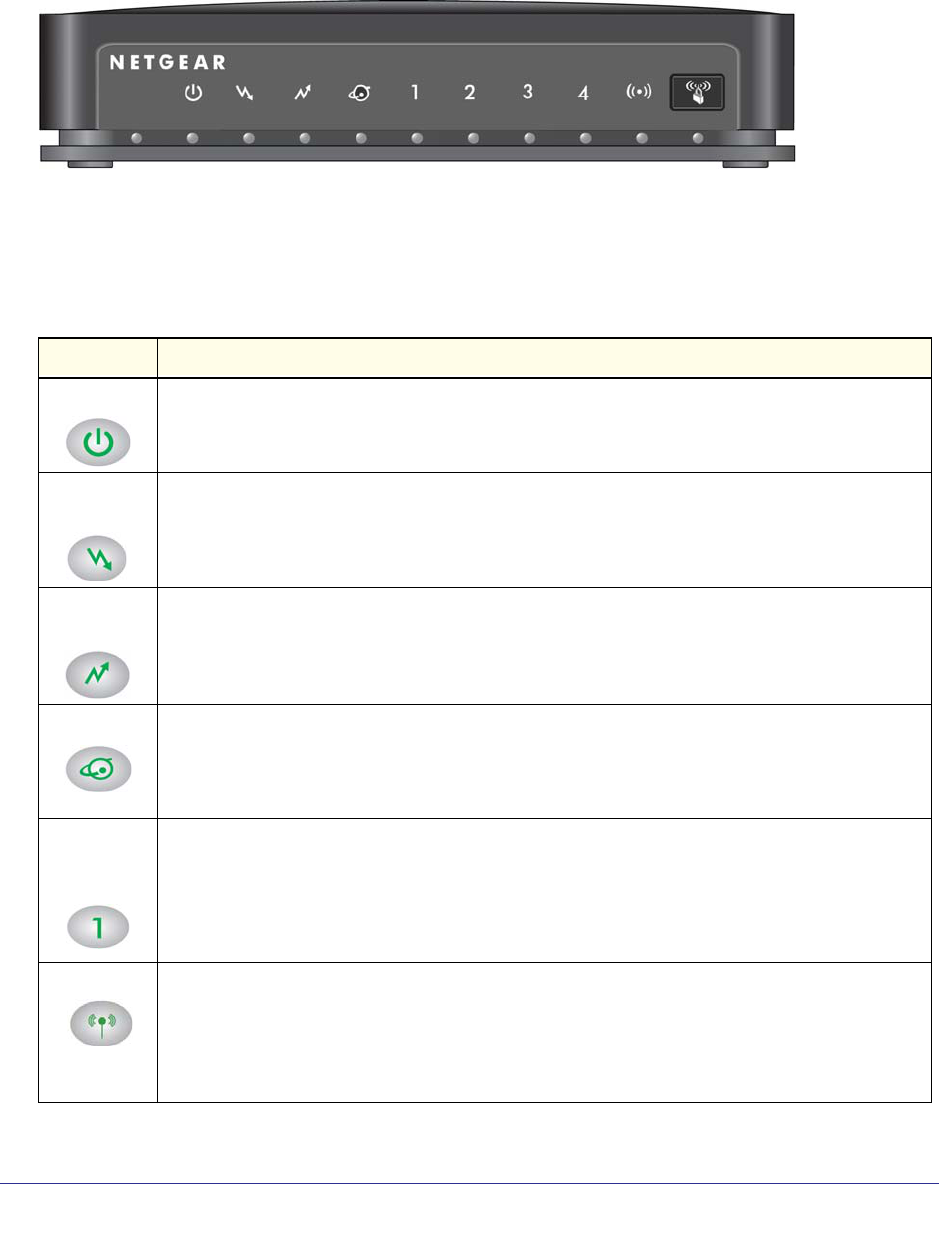
6 | Chapter 1. Connecting the Gateway to the Internet
Wireless Cable Modem Gateway CG2003D User Manual
Front Panel
The front panel of the Wireless Cable Modem Gateway contains status LEDs.
WPS
button
Figure 2. Front view
You can use the LEDs to verify connections.The following table lists and describes each LED
on the front panel of the gateway.
Table 1. LED Descriptions
LED Description
Power • On: Power is supplied to the gateway, and the gateway has completed its initialization.
• Off: Power is not supplied to the gateway.
Downstream
Link
• On: The gateway completed its downstream scan.
• Blink: The gateway has just powered up or it is performing a downstream scan.
• Off: The gateway’s self-test and initialization is complete but it has not completed the
downstream scan.
Upstream
Link
• On: The gateway has completed its upstream ranging operation.
• Blink: The gateway has just powered up or it is getting upstream configuration information.
• Off: The gateway’s self-test and initialization is complete but it has not completed the
upstream scan.
Cable Link • On (green): Configuration by your cable service provider is complete.
• Blink: Both downstream and upstream links are established, but the configuration is not done.
• Off: Configuration of the cable interface is in progress. The downstream and upstream links
have not been established yet.
LAN
(local area
network)
• On (green): The port has detected link with a 100 Mbps device.
• Blink (green): Data is being transmitted or received at 100 Mbps.
• On (yellow): The Local port has detected link with a 10 Mbps device.
• Blink (yellow): Data is being transmitted or received at 10 Mbps.
• Off: No link is detected on this port.
Wireless • On: The wireless access point is operating normally.
• Blink: Data is being transmitted or received on the wireless interface.
• Blink in a fast pattern: The gateway attempts to establish a connection to a wireless client
through Wi-Fi Protected Setup (WPS).
• Off: The wireless access point is disabled.
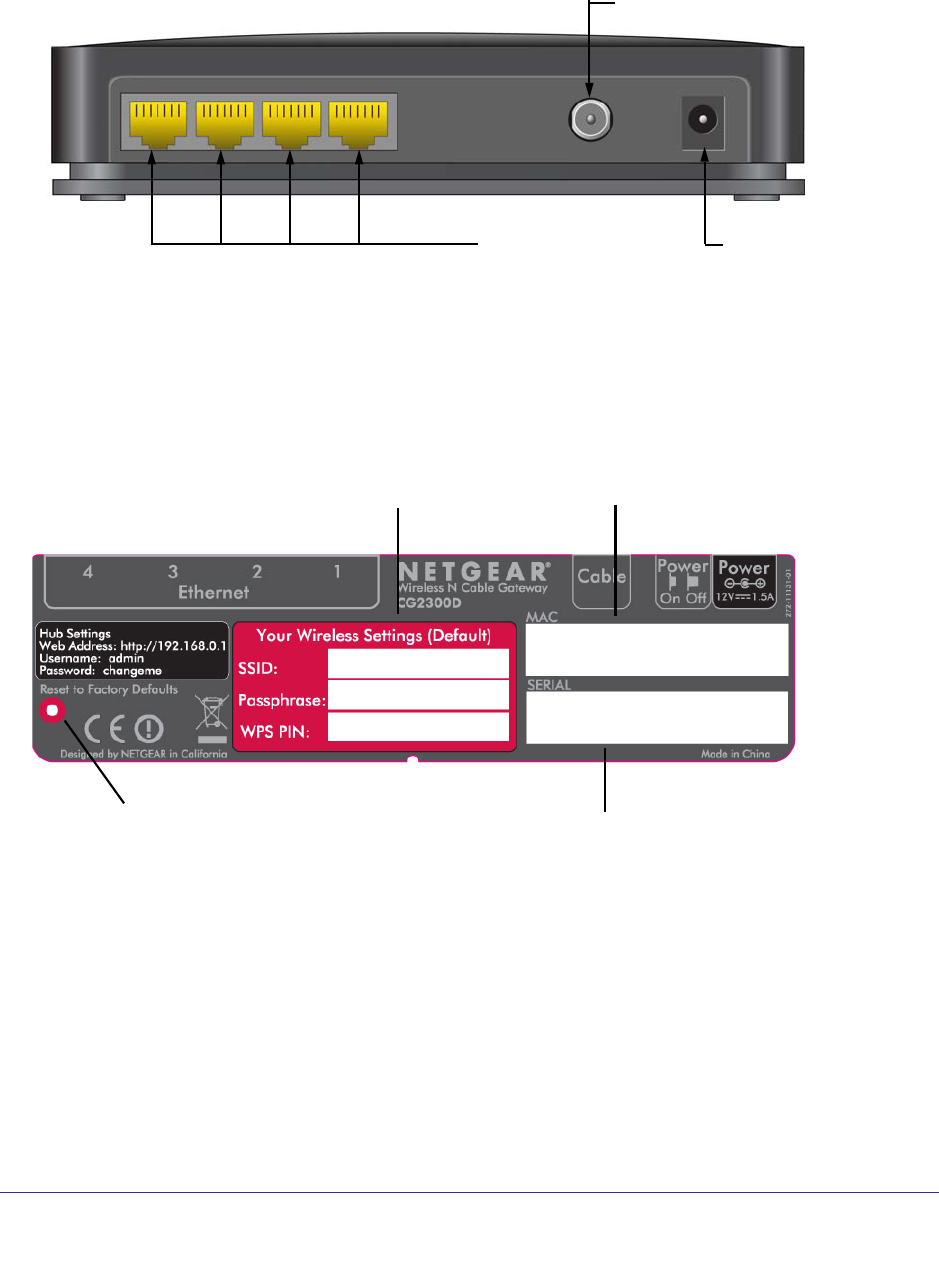
Chapter 1. Connecting the Gateway to the Internet | 7
Wireless Cable Modem Gateway CG2003D User Manual
Rear Panel
The rear panel of the gateway contains the connections identified below:
AC power adapter
4 Ethernet LAN ports
coaxial cable
input
Figure 3. Rear view
Label
The label on the bottom of the gateway shows the gateway’s factory reset button, its default
wireless settings, MAC address, and serial number.
Reset to Factory Defaults button Serial number
MAC address
Default wireless settings
Figure 4. Label on gateway bottom
What You Need Before You Begin
• A computer with an Ethernet port to connect to the gateway while you set it up. The
computer has to be set up to use DHCP. For help with DHCP configuration, see the link to
the online document ITCP/IP Networking Basics in Appendix B.
• Active Data Over Cable Internet service provided by cable modem account.
• The Internet Service Provider (ISP) configuration information for your cable modem
account.

8 | Chapter 1. Connecting the Gateway to the Internet
Wireless Cable Modem Gateway CG2003D User Manual
Cabling the Gateway
1. Using the coaxial cable provided by your cable company, connect the gateway cable
port (A) to your cable line splitter or outlet.
A
Figure 5. Gateway coaxial cable connection
2. Use the Ethernet cable that shipped with your gateway to connect a LAN port (B) to the
Ethernet adapter in your computer.
B
Figure 6. Gateway Ethernet cable connection
3. Connect the power adapter to the gateway, and plug it into an outlet.
4. Wait about 30 seconds for the lights to stop blinking, and then verify the following:
The power LED is lit.
The cable link LED is solid green, indicating a link has been established to the
cable network.

Chapter 1. Connecting the Gateway to the Internet | 9
Wireless Cable Modem Gateway CG2003D User Manual
Log in to the Gateway
You can log in to the gateway to view or change its settings. You can use an Ethernet cable to
connect the computer to the gateway, or you can connect wirelessly.
1. Using the computer that you first used to access your cable modem Internet service,
type http://192.168.0.1 in the address field of your Internet browser. A login window
opens.
2. Log in to the gateway.
There are two methods to log in:
• For superuser access, enter MSO for the user name and changeme for the
password. Both are case-sensitive.
• To access the gateway features except for content filtering, enter admin for the
user name and password for the password, both in lower case letters.
When you connect to the gateway, the Gateway Status screen displays.
For more information about this screen, see Gateway Status on page 33.
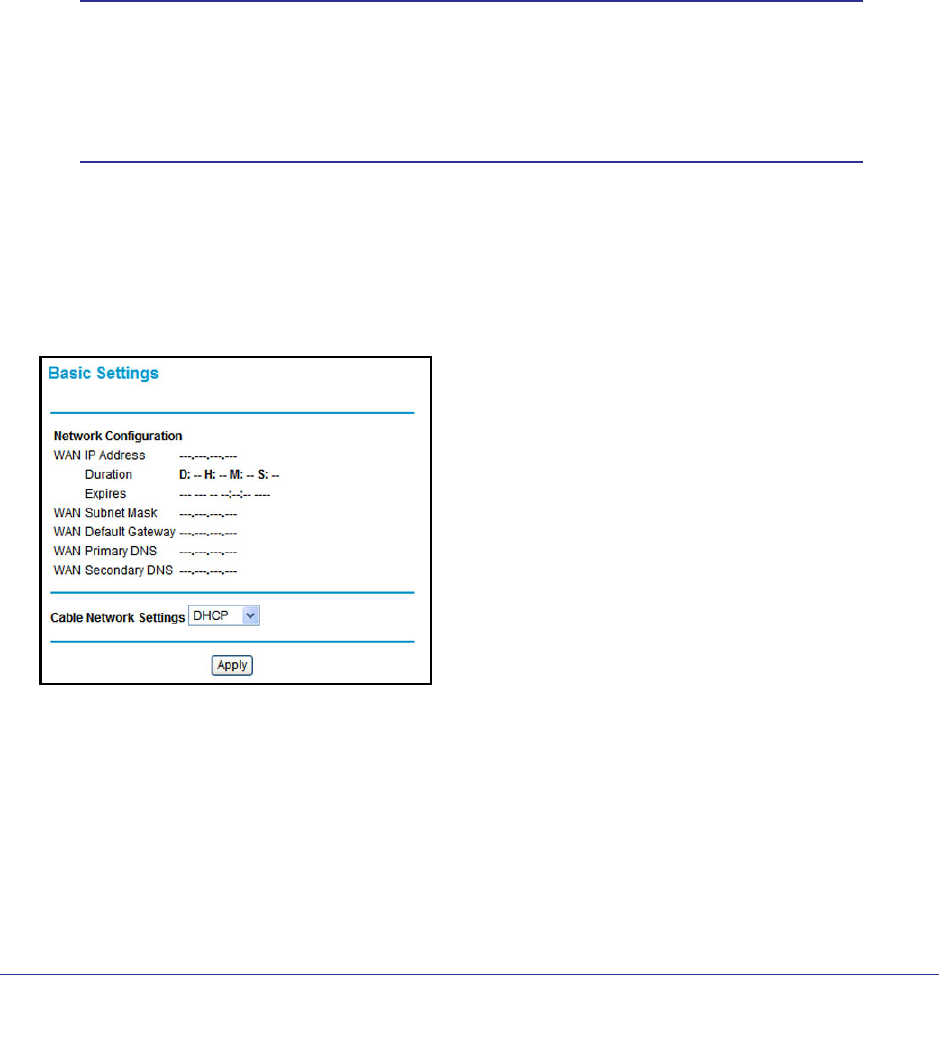
10 | Chapter 1. Connecting the Gateway to the Internet
Wireless Cable Modem Gateway CG2003D User Manual
If you do not see the login prompt:
1. Check the LEDs on the gateway front panel to make sure that the gateway is plugged
into an electrical outlet, its power is on, and the Ethernet cable between your computer
and the gateway is connected to a LAN port.
2. If you connected the Ethernet cable and quickly launched your browser and typed in the
router URL, your computer might need a minute or two to recognize the LAN connection.
Relaunch your browser and try again.
3. If you are having trouble accessing the gateway wirelessly, NETGEAR recommends that
during setup you use an Ethernet cable to connect your computer so that you can log in to
the gateway.
Note: If you cannot connect to the gateway, check the Internet Protocol
(TCP/IP) properties in the Network Connections section of your PC
Control Panel. They should be set to obtain both IP and DNS server
addresses automatically. See your computer documentation or
follow the links in Related Documents on page 146 for assistance.
Basic Cable Network Settings
To configure the cable network settings, in the main menu, under Setup, select Basic
Settings. The Basic Settings screen displays.
The default setting is for DHCP. Click Apply to save your settings. After you connect to the
Internet, the network configuration settings on this screen match the cable network settings.

Chapter 2. Wireless Settings | 11
2
2. Wireless Settings
For a wireless connection, you need to set up your wireless computer or device to use the
gateway’s SSID, also called the wireless network name, and wireless security settings.
NETGEAR strongly recommends that you use wireless security.
This chapter includes:
• Wireless Adapter Compatibility on this page
• Security Basics on page 12
• Add Clients (Computers or Devices) to Your Network on page 13
• Wireless Settings Screen on page 14
• Wireless Guest Networks on page 20
• Set up Wi-Fi Multimedia on page 21
Wireless Adapter Compatibility
A wireless adapter is the wireless radio in your PC or laptop that lets the PC or laptop
connect to a wireless network. Most PCs and laptops come with an adapter already installed,
but if it is outdated or slow, you can purchase a USB adapter to plug into a USB port.
Make sure the wireless adapter in each computer in your wireless network supports the
same security settings as the gateway.
Note: If you connect devices to your gateway using WPS as described in
Wi-Fi Protected Setup (WPS) Method on page 13, those devices
assume the security settings of the gateway.

12 | Chapter 2. Wireless Settings
Wireless Cable Modem Gateway CG2003D User Manual
Security Basics
Unlike wired network data, wireless data transmissions extend beyond your walls and can be
received by any device with a compatible wireless adapter (radio). For this reason, it is very
important to maintain the preset security and understand the other security features available
to you. Besides the preset security settings described above, your gateway has the security
features described here and in Chapter 4, Content Filtering Settings.
• Disable SSID broadcast
• Restrict access by MAC address
• Wireless security options
Disable SSID Broadcast
By default, the gateway broadcasts its Wi-Fi network name (SSID) so devices can find it. If
you change this setting to not allow the broadcast, wireless devices will not find your gateway
unless they are configured with the same SSID. See Wireless Access Point Settings on
page 16 for the procedure.
Turning off SSID broadcast nullifies the wireless network discovery feature of some products
such as Windows XP, but the data is still exposed to a determined snoop using specialized
test equipment like wireless sniffers. If you allow the broadcast, be sure to keep wireless
security enabled.
Restrict Access by MAC Address
You can enhance your network security by allowing access to only specific PCs based on
their Media Access Control (MAC) addresses. You can restrict access to only trusted PCs so
that unknown PCs cannot wirelessly connect to the gateway.The Wireless Station MAC
address filtering adds additional security protection to the wireless security option that you
have in force. Access List determines which wireless hardware devices are allowed to
connect to the gateway by MAC address. See Advanced Wireless Settings on page 79 for
the procedure.
Wireless Security Options
A security option is the type of security protocol applied to your wireless network. The
security protocol encrypts data transmissions and ensures that only trusted devices receive
authorization to connect to your network. There are several types of encryption: Wi-Fi
Protected Access II (WPA2), WPA, and Wired Equivalent Privacy (WEP). WPA2 is the most
recent, and is recommended if your equipment supports it. WPA has several options
including pre-shared key (PSK) encryption and 802.1x encryption for enterprises. Note that it
is also possible to disable wireless security. NETGEAR does not recommend this. You can
view or change the wireless security options in the Wireless Settings screen. See Wireless
Settings Screen on page 14.

Chapter 2. Wireless Settings | 13
Wireless Cable Modem Gateway CG2003D User Manual
Add Clients (Computers or Devices) to Your Network
Choose either the manual or the WPS method to add wireless computers or devices to your
wireless network.
Manual Method
1. Open the software that manages your wireless connections on the wireless device
(laptop computer, gaming device, iPhone) that you want to connect to your gateway.
This software scans for all wireless networks in your area.
2. Look for your network and select it. If you did not change the name of your network during
the setup process, look for the default Wi-Fi network name (SSID) and select it. The default
Wi-Fi network name (SSID) is located on the product label on the bottom of the gateway.
3. Enter the gateway passphrase and click Connect. The default gateway passphrase is
located on the product label on the bottom of the gateway.
4. Repeat steps 1–3 to add other wireless devices.
Wi-Fi Protected Setup (WPS) Method
Wi-Fi Protected Setup (WPS) is a standard that lets you easily join a secure wireless network
with WPA or WPA2 wireless security. The gateway automatically sets security for each
computer or device that uses WPS to join the wireless network. To use WPS, make sure that
your wireless devices are Wi-Fi certified and support WPS. NETGEAR products that use
WPS call it Push 'N' Connect1.
Note: If the wireless network name (SSID) changes each time you add a
WPS client, the Keep Existing Wireless Settings check box on the
Advanced Wireless Settings screen has been cleared. See WPS
Settings on page 80 for more information about this setting.
You can use a WPS button or the gateway interface method to add wireless computers and
devices to your wireless network.
WPS Button Method
1. Press the WPS button on the gateway front panel .
2. Within 2 minutes, press the WPS button on your wireless computer or device, or follow the
WPS instructions that came with the computer. The device is now connected to your
gateway.
3. Repeat steps 1 and 2 to add other WPS wireless computers or devices.
1. For a list of other Wi-Fi-certified products available from NETGEAR, go to http://www.wi-fi.org.

14 | Chapter 2. Wireless Settings
Wireless Cable Modem Gateway CG2003D User Manual
Gateway Interface Method
1. Select Add WPS Client at the top of the gateway menus.
2. Click Next. The following screen lets you select the method for adding the WPS client.
WPS Push button method
3. Select either Push Button or PIN Number. With either method, the gateway tries to
communicate with the computer or wireless device, set the wireless security for wireless
device, and allow it to join the wireless network.
The PIN method displays this screen so you can enter the client security PIN number:
WPS PIN method
While the gateway attempts to connect, the WPS LED on the front of the gateway blinks
green. When the gateway establishes a WPS connection, the LED is solid green and the
gateway WPS screen displays a confirmation message.
4. Repeat to add another WPS client to your network.
Wireless Settings Screen
The Wireless Settings screen lets you view or change the wireless network settings. If you
change the settings, note the new settings and save them in a secure location.
Note: If you use a wireless computer to change the wireless network name
(SSID) or security options, you are disconnected when you click
Apply. To avoid this problem, use a computer with a wired
connection to access the gateway.

Chapter 2. Wireless Settings | 15
Wireless Cable Modem Gateway CG2003D User Manual
Consider Every Device on Your Network
Before you begin, check the following:
• Every wireless computer has to be set up to get an IP address by DHCP from the
gateway as described in Use Standard TCP/IP Properties for DHCP on page 18.
• To join your wireless network, each computer or wireless adapter has to be compatible
with the wireless mode (bandwidth/data rate) of the gateway. Check that each wireless
computer or device supports the mode you want to use.
• The security option on each wireless device in the network has to match the gateway. For
example, if you use WPA2 or WPA, you need to use the pre-shared key from each
wireless computer in order for it to join the wireless network.
View or Change Wireless Settings
To view or change the wireless settings:
1. Select Setup > Wireless Settings. The Wireless Settings screen displays.
2. If you make changes, you have to click Apply for them to take effect.

16 | Chapter 2. Wireless Settings
Wireless Cable Modem Gateway CG2003D User Manual
The following sections describe the fields in the Wireless Settings screen.
Wireless Network
• Name (SSID). The SSID is also known as the wireless network name. Enter a
32-character (maximum) name in this field. This field is case-sensitive. The default SSID
is randomly generated, and there is typically no need to change it. If you want to set up
guest networks, NETGEAR does recommend that you customize the default guest
network names (SSIDs).
• Channel. The wireless channel used by the gateway: 1 through 13. Do not change the
channel unless you experience interference (shown by lost connections or slow data
transfers). If this happens, experiment with different channels to see which is the best.
Wireless Access Point Settings
• Enable. When this check box is not selected, the wireless signal in the gateway so it can
accept wireless clients. When not enabled, the gateway accepts wired clients only. This
check box is selected by default.
• Allow Broadcast of Name (SSID). This setting allows the gateway to broadcasts its
SSID so wireless stations can see this wireless name (SSID) in its scanned network list.
This check box is selected by default. To turn off the SSID broadcast, clear the Allow
Broadcast of Name (SSID) check box and click Apply.
Wireless Card Access List
By default, any wireless PC that is configured with the correct SSID and network password is
allowed to join your wireless network. For increased security, you can restrict access to the
wireless network to only allow specific PCs based on their MAC addresses.
Set up Access Control by MAC Address
When you enable access control, the access point only accepts connections from clients on the
selected access control list. This provides an additional layer of security
To restrict access based on MAC addresses:
1. In the Wireless Settings screen, select the Turn Access Control On check box.
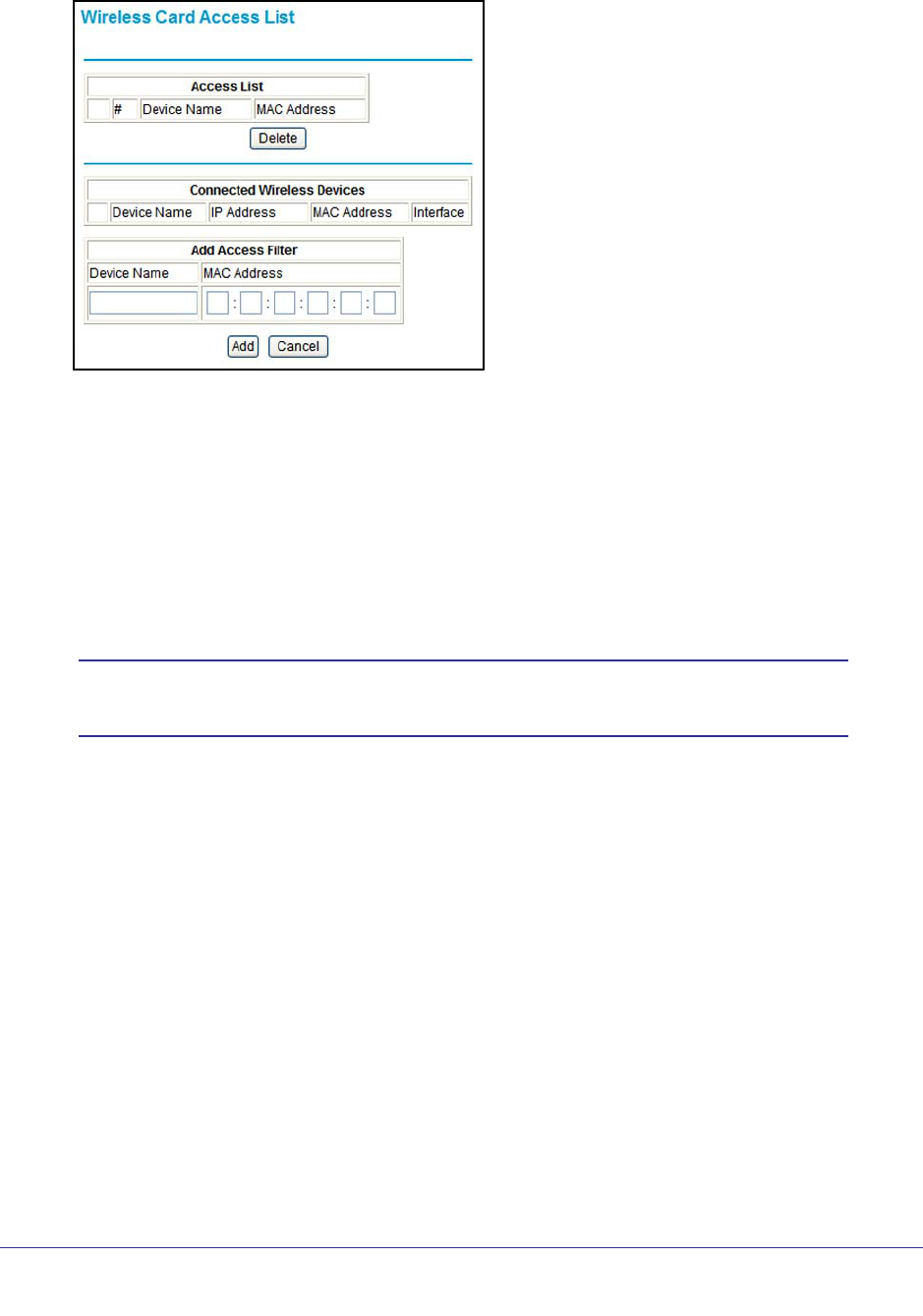
Chapter 2. Wireless Settings | 17
Wireless Cable Modem Gateway CG2003D User Manual
2. Click the Setup Access List button to display the Wireless Card Access List screen.
By default, the Access List table is empty. You need to add wireless devices here so that
they will have access to the wireless network when the list is enabled.
3. Adjust the access list as needed for your network. You can add devices to the access list
using either of the following methods:
• If the computer is in the Connected Wireless Devices table, click the radio button of
that computer to capture its MAC address. Then click Add.
• Enter the MAC address of the device in the Add Access Filter fields. The MAC
address can usually be found on the bottom of the wireless device. Then click Add.
Note: If no device name displays when you enter the MAC address, you
can type a descriptive name for the computer that you are adding.
4. Click Apply to save these settings. Now, only devices in the Access List table are allowed to
wirelessly connect to the gateway.
Security Options Settings
The Security Options section of the Wireless Settings screen lets you change the security
option and passphrase. The primary network for your gateway is already set up with WPA2
and WPA security. NETGEAR recommends that you set up wireless security for each guest
network that you plan to use.For information about changing these settings, see the following
section, Change the WPA Security Option and Pre-Shared Key on page 18and Set WEP
Encryption and Passphrase on page 19.

18 | Chapter 2. Wireless Settings
Wireless Cable Modem Gateway CG2003D User Manual
Change the WPA Security Option and Pre-Shared Key
1. In the Security Options section, select the WPA option that you want.
2. Enter the pre-shared key that you want to use. The pre-shared key acts as a password to
access your wireless network. It is a text string from 8 to 63 characters.
3. Click Apply.

Chapter 2. Wireless Settings | 19
Wireless Cable Modem Gateway CG2003D User Manual
Set WEP Encryption and Passphrase
1. In the Security Options section of the Wireless Settings screen, select the WEP radio
button that you want.
2. Enter the four data encryption keys either manually or automatically. These values have to
be identical on all computers and access points in your network.
• Automatic. Enter a word or group of printable characters in the Passphrase field and
click Generate. The four key fields are automatically populated.
• Manual. The number of hexadecimal digits that you enter depends on the encryption
strength setting:
- For 64-bit WEP, enter 10 hexadecimal digits (any combination of 0–9, a–f, or
A–F).
- For 128-bit WEP, enter 26 hexadecimal digits (any combination of 0–9, a–f, or
A–F).
3. Select the radio button for the key you want to make active.
Make sure you understand how to set up the WEP key settings in your wireless
computers or adapters. Wireless adapter configuration utilities such as the one in
Windows XP allow one key entry, which has to match the default key you set in the
gateway.
4. Click Apply.
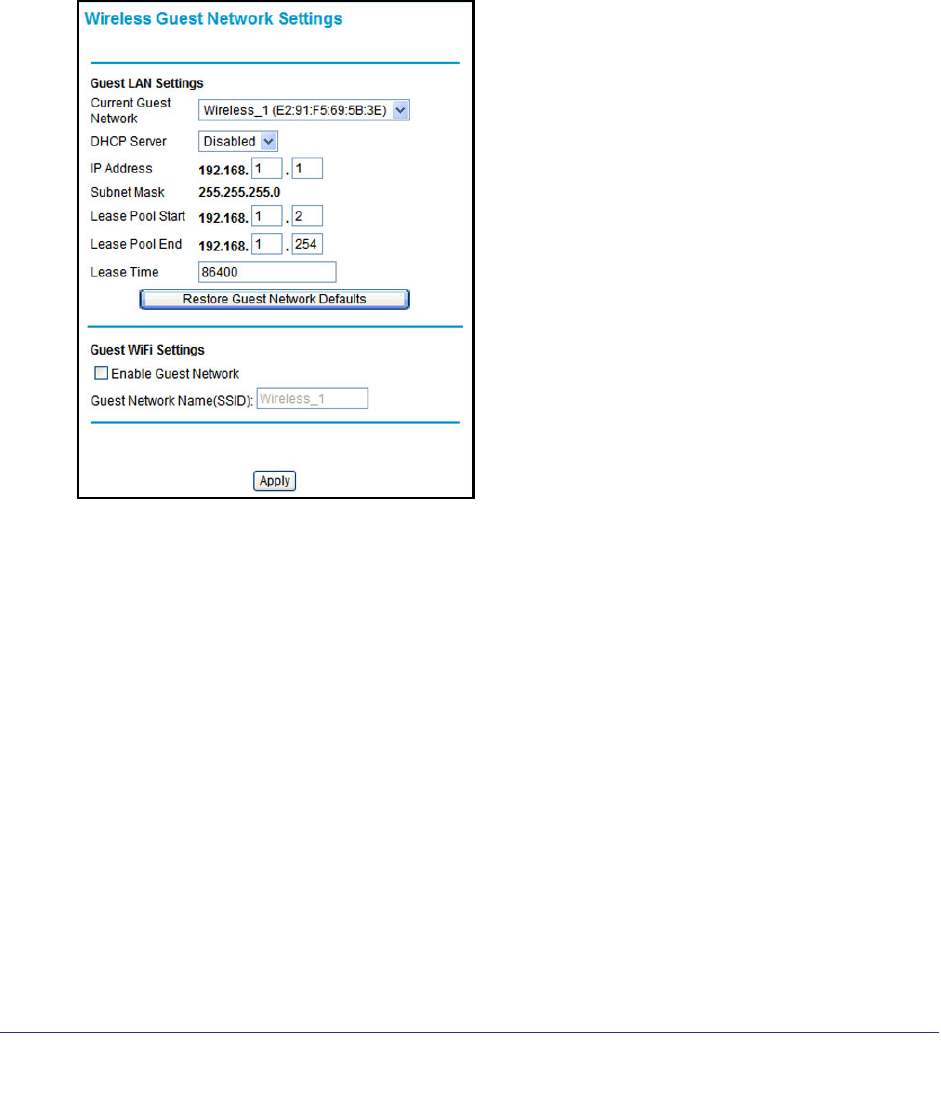
20 | Chapter 2. Wireless Settings
Wireless Cable Modem Gateway CG2003D User Manual
Wireless Guest Networks
A wireless guest network allows you to provide guests access to your wireless network
without prior authorization of each individual guest. You can wet up 3 wireless guest networks
and specify the security options for each wireless guest network.
To set up a wireless guest network:
1. Select Setup > Wireless Guest Network.
2. Select the guest network that you want to work with.
• NETGEAR strongly recommends that you change the SSID to a different name. Note
that the SSID is case-sensitive. For example, GuestNetwork is not the same as
Guestnetwork.
• For guest networks, wireless security is disabled by default. NETGEAR strongly
recommends that you implement wireless security for the guest network.
3. Select a security option for the guest network and specify the password.
4. Select the Enable Guest Network check box.
5. You can now change the Guest Network Name (SSID) for the selected guest network. Enter
a value of up to 32 alphanumeric characters.
6. When you have finished making changes, click Apply.

Chapter 2. Wireless Settings | 21
Wireless Cable Modem Gateway CG2003D User Manual
Wireless Guest Network Screen Fields
Guest LAN Settings
• Current Guest Network. You can select a guest network from the drop-down list.
• DHCP Server. Select whether or not the DHCP server is enabled for the currently
selected guest network.
• IP Address. Enter the IP address for the guest network. The default IP addresses are as
follows:
-192.168.1.1
-192.168.2.1
-192.168.3.1
The subnet mask has a permanent address of 255.255.255.
• Lease Pool Start and Lease Pool End. Enter the lease pool start and end IP address for
the guest network. The default lease pool start IP addresses are as follows:
-192.168.1.10 and 192.168.1.99
-192.168.2.10 and 192.168.2.99
-192.168.3.10 and 192.168.3.99
• Lease Time. Enter the lease time for the guest network. The default is 86400 seconds
(24
hours).
• Enable Guest Network check box.
• Guest Network Name (SSID). You can use this field to change the SSID for the selected
guest network.
Set up Wi-Fi Multimedia
Wi-Fi Multimedia (WMM), also referred to as Wireless Multimedia, is a subset of the 802.11e
standard. WMM allows wireless traffic to have a range of priorities, depending on the kind of
data. Time-dependent information, like video, audio, or voice have a higher priority than
normal traffic.With WMM you can configure quality of service (QoS) to prioritize multimedia
traffic in four access categories: voice, video, best effort, and background. For WMM to
function correctly, wireless clients have to support WMM.

22 | Chapter 2. Wireless Settings
Wireless Cable Modem Gateway CG2003D User Manual
To configure WMM:
1. Select Setup > Wi-Fi Multimedia. The Wi-Fi Multimedia (WMM) screen displays.
2. Enter the following WMM settings:
• WMM Support. Select the WMM mode:
- On. WMM is enabled
- Off. WMM is disabled.
• No-Acknowledgement. When the wireless communication quality is good, you do
not need an acknowledgement message (ACK) to confirm the reception of a packet.
Disabling acknowledgement messages might improve the efficiency of packet
transmission. When the wireless communication quality is poor, enable
acknowledgement messages so that you are notified when a package is lost.
- On. Acknowledgement messages are enabled.
- Off. Acknowledgement messages are disabled.
• Power Save Support. Select the power save mode to conserve battery power in
smaller devices that are connected to the gateway:
- On. Power save support is enabled.
- Off. Power save support is disabled.
3. Click Apply to save your settings.

Chapter 3. Content Filtering and Firewall Rules | 23
3
3. Content Filtering and Firewall Rules
This chapter describes how to use content filtering and firewall rules for the gateway.
This chapter includes:
• Logs on page 24
• Block HTTP Traffic by Keywords or Domains on page 25
• Block Services on page 26
• Port Forwarding and Port Blocking on page 27
• Set Up Port Blocking on page 27
• Set Up Port Forwarding on page 28
• Set up Port Triggering on page 30

24 | Chapter 3. Content Filtering and Firewall Rules
Wireless Cable Modem Gateway CG2003D User Manual
Logs
To access this feature you have to log in to the gateway with the MSO user name and its
default password changeme, or whatever new password you have set up.
A log is a detailed record of the Denial of Service (DoS) attacks directed at your network. You
can use e-mail notification to receive these logs in an e-mail message. If you do not have
e-mail notification set up you can connect to the gateway to view the logs.
To receive logs or alerts by email:
1. Select Content Filtering > Logs. The Logs screen displays.
2. Enter the following information:
• Contact Email Address. Enter an email address to which the logs will be sent. Use a
full email address (for example, ChrisXY@myISP.com).
• SMTP Server Name. Enter the outgoing SMTP mail server of your ISP (for example,
mail.myISP.com). If you leave this box blank, no alerts or logs will be sent.
• Sender Email Address. Enter an e-mail address from which the logs will be sent.
Use a full e-mail address (for example, JohnXY@myISP.com).
3. Select the SMTP Server Authentication check box if authentication is required.
4. Select the Email Alerts Enable check box to activate the e-mail alerts.
5. Click Apply to save your settings.
For information about event logs, see Event Log on page 36.

Chapter 3. Content Filtering and Firewall Rules | 25
Wireless Cable Modem Gateway CG2003D User Manual
Block HTTP Traffic by Keywords or Domains
Use keyword blocking to prevent certain types of HTTP traffic from accessing your network.
1. Select Security > Block Sites.s
2. In the Add Keyword field, enter a keyword and click Add Keyword.
The Keyword List supports up to 32 entries.
3. In the Add Domain field, enter a domain and click Add Domain.
Here are some sample entries:
• Specify XXX to block http://www.badstuff.com/xxx.html
• Specify .com if you want to allow only sites with domain suffixes such as .edu or .gov
• Enter a period (.) to block all Internet browsing access.
4. When you are finished making changes, click Apply.
Note: To delete a keyword or domain, select it from the list, click Remove
Keyword or Remove Domain, and then click Apply.

26 | Chapter 3. Content Filtering and Firewall Rules
Wireless Cable Modem Gateway CG2003D User Manual
Block Services
To access this feature you have to log in to the gateway with the MSO user name and its
default password changeme, or whatever new password you have set up.
You can use the Services screen to control which services are enabled or disabled. To enable
or disable certain gateway features and web features:
1. Select Content Filtering > Services. The Services screen displays.
2. To enable a service, select its check box. To disable a service, clear its check box.
• Firewall Features. When firewall features are enabled, the gateway performs stateful
packet inspection (SPI) and protects against denial of service (DoS) attacks.
• Ipsec PassThrough. When Ipsec passthrough is enabled, IPSec traffic is forwarded.
When it is disabled, this traffic is blocked.
• PPTP PassThrough. When PPTP passthrough is enabled, PPTP traffic is forwarded.
When it is disabled, this traffic is blocked.
• Multicast. When multicast is enabled, the gateway passes multicasting streams
through the firewall.
• Web Features. When enabled, these features are not blocked by the firewall. When
disabled, these features are blocked by the firewall. You can enable or disable each of
these features individually.
3. Click Apply to save your settings.
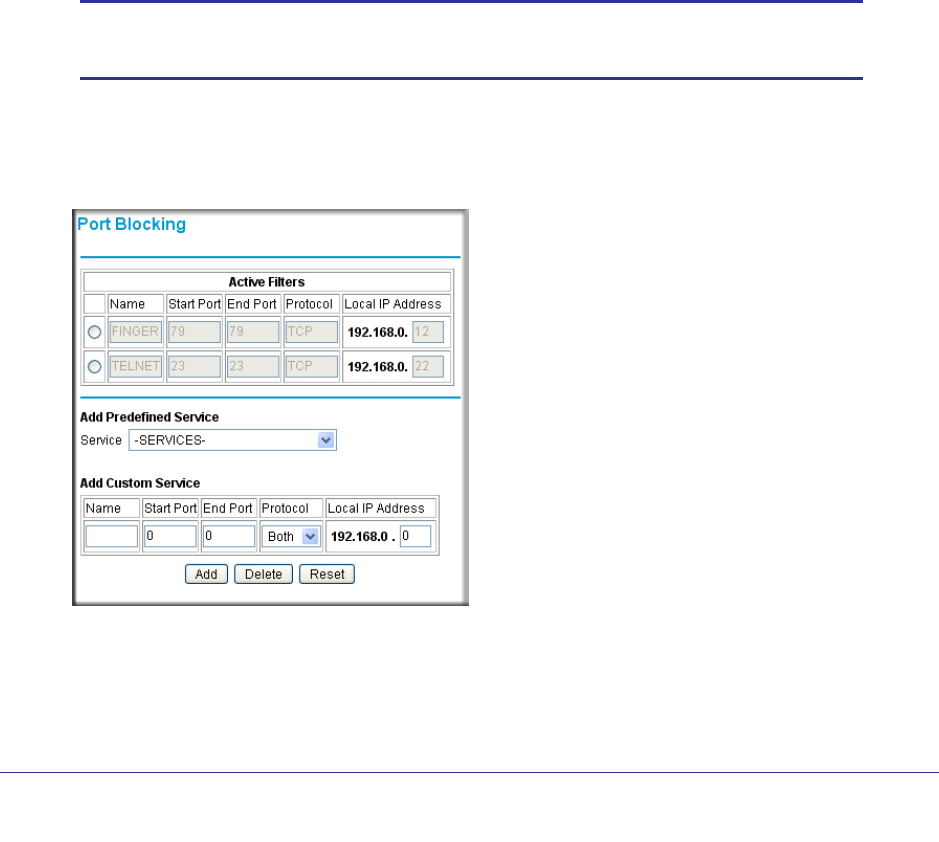
Chapter 3. Content Filtering and Firewall Rules | 27
Wireless Cable Modem Gateway CG2003D User Manual
Port Forwarding and Port Blocking
A firewall has two default rules, one for inbound traffic (WAN to LAN) and one for outbound
traffic.
• Inbound Rules (Port Forwarding)
These rules restrict access from outsiders. The default rule is to block all access from
outside except responses to requests from the LAN side. You can use port forwarding to
add predefined or custom rules to specify exceptions to the default rule.
• Outbound Rules (Port Blocking)
These rules control access to outside resources from local users.The default rule is to
allow all access from the LAN side to the outside. You can use port blocking to add
predefined or custom rules to specify exceptions to the default rules.
Set Up Port Blocking
You can use port blocking to block outbound traffic on specific ports.
Note: Any outbound traffic that is not blocked by rules that you have
created is allowed by the default rule.
To configure port blocking and services to block specific outbound traffic:
1. Select Advanced > Port Blocking. The Port Blocking screen displays.
2. Under Add Predefined Service, select a predefined service from the Service field. (For
example, FTP, which uses TCP ports 20 and 21.)

28 | Chapter 3. Content Filtering and Firewall Rules
Wireless Cable Modem Gateway CG2003D User Manual
3. As an option, you can also specify a custom rule that is not in the list of predefined services
by specifying the following settings in the Add Custom Service table:
• Name. Enter a name for the service.
• Start Port. Enter the start port for the service.
• End Port.Enter the end port for the service.
• Protocol. Select the protocol for the ports:
- TCP. Select TCP only.
- UDP. Select UDP only.
- Both. Select both TCP and UDP.
• Local IP Address. Complete the local IP address for the computer that is using the
service.
Note: To reset the selection in the Service field and to clear all the fields in
the Add Custom Rules table, click Reset.
4. Perform one of the following actions:
• Click Add to save your settings. The Active Filters table now displays the list of ports
that are currently forwarded.
• To delete a service, select the radio button in the Active Filters table for the service
that you want to delete, and then click Delete.
Set Up Port Forwarding
Because the gateway uses Network Address Translation (NAT), your network presents only
one IP address to the Internet, and outside users cannot directly address any of your local
computers. However, by defining an inbound rule you can make a local server (for example, a
web server or game server) or computer visible and available to the Internet. The rule tells
the Gateway to direct inbound traffic for a particular service to one local server or computer
based on the destination port number. This is also known as port forwarding.
Note: Some residential broadband ISP accounts do not allow you to run
any server processes (such as a Web or FTP server) from your
location. Your ISP may periodically check for servers and may
suspend your account if it discovers any active services at your
location. If you are unsure, refer to the Acceptable Use Policy of your
ISP.

Chapter 3. Content Filtering and Firewall Rules | 29
Wireless Cable Modem Gateway CG2003D User Manual
To configure port forwarding and services for specific inbound traffic:
1. Select Advanced > Port Forwarding. The Port Forwarding screen displays.
2. Under Choose Predefined Service, select a predefined service from the Service field. (For
example, FTP, which uses TCP ports 20 and 21.)
3. As an option, you can also specify a custom rule that is not in the list of predefined services
by specifying the following settings in the Add Custom Rules table:
• Name. Enter a name for the service.
• Start Port. Enter the start port for the service.
• End Port.Enter the end port for the service.
• Protocol. Select the protocol for the ports:
- TCP. Select TCP only.
- UDP. Select UDP only.
- Both. Select both TCP and UDP.
• Local IP Address. Complete the local IP address for the computer that is using the
service.
Note: To reset the selection in the Service field and to clear all the fields in
the Add Custom Rules table, click Reset.
4. Perform one of the following actions:
• Click Add to save your settings. The Active Forwarding Rules table now displays the
list of ports that are currently forwarded.
• To delete a service, select the radio button in the Active Forwarding Rules table for
the service that you want to delete, and then click Delete.

30 | Chapter 3. Content Filtering and Firewall Rules
Wireless Cable Modem Gateway CG2003D User Manual
Considerations for Port Forwarding
• If the IP address of the local server PC is assigned by DHCP, it may change when the PC
is rebooted. To avoid this, you can assign a static IP address to your server outside the
range that is assigned by DHCP, but in the same subnet as the rest of your LAN. By
default, the IP addresses in the range of 192.168.0.2 through 192.168.0.9 are reserved
for this purpose.
• Local PCs access the local server using the PCs’ local LAN address (192.168.0.XXX, by
default). Attempts by local PCs to access the server using the external WAN IP address
will fail.
Remember that allowing inbound services opens holes in your firewall. Only enable those
ports that are necessary for your network.
Set up Port Triggering
Port triggering is an advanced feature that can be used to easily enable gaming and other
Internet applications that would otherwise be blocked by the firewall. Using this feature
requires that you know the port numbers that are used by the application.
Once set up, port triggering operation is as follows:
1. A PC makes an outgoing connection using a port number defined in the Port Triggering
table.
2. The gateway records this connection, opens the incoming port or ports associated with this
entry in the Port Triggering List, and associates them with the PC.
3. The remote system receives the PCs request, and responds using a different port number.
4. The gateway matches the response to the previous request, and forwards the response to
the PC. (Without port triggering, this response would be treated as a new connection request
rather than a response. As such, it would be handled in accordance with the port forwarding
rules.)
Note: Only one PC can use a port triggering application at any time. After
a PC has finished using a port triggering application, there is a short
time-out period before the application can be used by another PC.

Chapter 3. Content Filtering and Firewall Rules | 31
Wireless Cable Modem Gateway CG2003D User Manual
To set up port triggering:
1. Select Advanced > Port Triggering. The Port Triggering screen displays.
2. For each port trigger that you would like to enable, enter the following settings in the Port
Trigger List and enable the port trigger:
• Trigger Range. The trigger range consists of the range of outgoing ports to be
monitored to trigger the incoming port forwarding rule:
- Start Port. Enter the start port for the trigger range.
- End Port. Enter the start port for the trigger range.
• Target Range. The target range consists of the range of incoming ports to be opened
when triggered:
- Start Port. Enter the start port for the target range.
- End Port. Enter the start port for the target range.
• Protocol. Select the protocol for the ports,:
- TCP. Select TCP only.
- UDP. Select UDP only.
- Both. Select both TCP and UDP.
• Select the Enable check box to activate the port trigger.
3. Perform one of the following actions:
• Click Apply to save your settings and activate the port triggers that you have enabled
in step 2.
• Click Delete to remove a port trigger that you can select by clicking the radio box next
to the port trigger that you want to delete.
• Click Reset to return all trigger and target ranges to their default values of zero.

Chapter 4. Managing Your Network | 32
4
4. Managing Your Network
This chapter describes how to perform network management tasks with your Wireless Cable
Modem Gateway. When you log in to the gateway, these tasks are grouped under Maintenance.
This chapter includes:
• Gateway Status on this page
• Connection Status on page 34
• Change Passwords on page 34
• Back Up and Restore Your Settings on page 36
• Event Log on page 36
• Run the Diagnostic Ping Utility on page 37
Log in to the gateway using its default address of http://192.168.0.1 or at whatever IP address
the unit is currently configured. Use the default user name of admin and default password of
password, or the password you have set up.

Chapter 4. Managing Your Network | 33
Wireless Cable Modem Gateway CG2003D User Manual
Gateway Status
Use the Gateway Status screen to see hardware and firmware details about the gateway and
to see basic status information. Select Maintenance > Gateway Status. The Gateway
Status screen displays.
The Gateway Status screen fields are explained in the following sections.
Information
• Standard Specification Compliant. The specification to which the gateway’s cable
interface is compatible.
• Hardware Version. The hardware version of the gateway.
• Software Version. The software version of the gateway.
• Cable MAC Address. The MAC address used by the cable modem port of the gateway.
This MAC address may need to be registered with your Cable Service Provider.
• gatewayCable Modem Serial Number. The serial number of the gateway.
• CM certificate. If the Cable Modem certificate is Installed, it is possible for the service
provider to upgrade your Data Over Cable service securely.
Status
• System Up Time. This is the time since the gateway has registered with your cable
service provider.
• Network Access. This field will change to Allowed when the registration with your cable
service provider is complete.
• Device IP Address. The IP address of your gateway, as seen from the Internet.

34 | Chapter 4. Managing Your Network
Wireless Cable Modem Gateway CG2003D User Manual
Connection Status
Use the Connection screen to track the gateway’s initialization procedure, and to get details
about the downstream and upstream cable channel. After the cable modem is initialized you
can see the current time.
This screen shows the progress of the steps that the gateway automatically goes through in
the provisioning process:
1. It acquires and locks the downstream channel
2. It acquires the upstream parameters and range.
3. It locks the upstream channel
4. It acquires the IP address through DHCP
Change Passwords
The gateway has two user names and passwords. They are case-sensitive.
• For superuser access, the user name is MSO and its default password is changeme.
• For access to all gateway features except content filtering, the user name is admin and
its default password is password for the password, both in lower case letters.
NETGEAR recommends that you change these passwords be more secure. The ideal
password should contain no dictionary words from any language, and should be a mixture of

Chapter 4. Managing Your Network | 35
Wireless Cable Modem Gateway CG2003D User Manual
both upper and lower case letters, numbers, and symbols. Passwords can be up to 30
characters.
To change a password:
1. Select Maintenance > Set Password. The Set Password screen displays.
2. To change the password, first enter the old password, and then enter the new password
twice.
3. Click Apply to save your changes.
Note: After changing the password, you will be required to log in again to
continue the configuration. If you have backed up the gateway
settings previously, you should do a new backup so that the saved
settings file includes the new password.
Reset to Factory Default Settings
You can erase the Gateway configuration and reset it to the factory default settings. For
information about the factory default settings, see Factory Default Settings in Appendix A. To
reset the gateway to its factory settings:
1. In the Set Password screen (see Figure 1, Select Maintenance > Set Password. The
Set Password screen displays.), to the right of Restore Factory Defaults, select the Yes
radio button.
2. Click Apply to save your changes.
The gateway reboots automatically. After rebooting, the gateway’s password will be
password, the LAN IP address will be 192.168.1.1, and the gateway’s DHCP client will
be enabled.
Note: If you do not know the login password or IP address, you can use
the reset button on the rear panel of the gateway to restore the
factory default settings. When erasing and resetting the
configuration, do not interrupt the process by going on online,
turning off the gateway, or shutting down the computer.
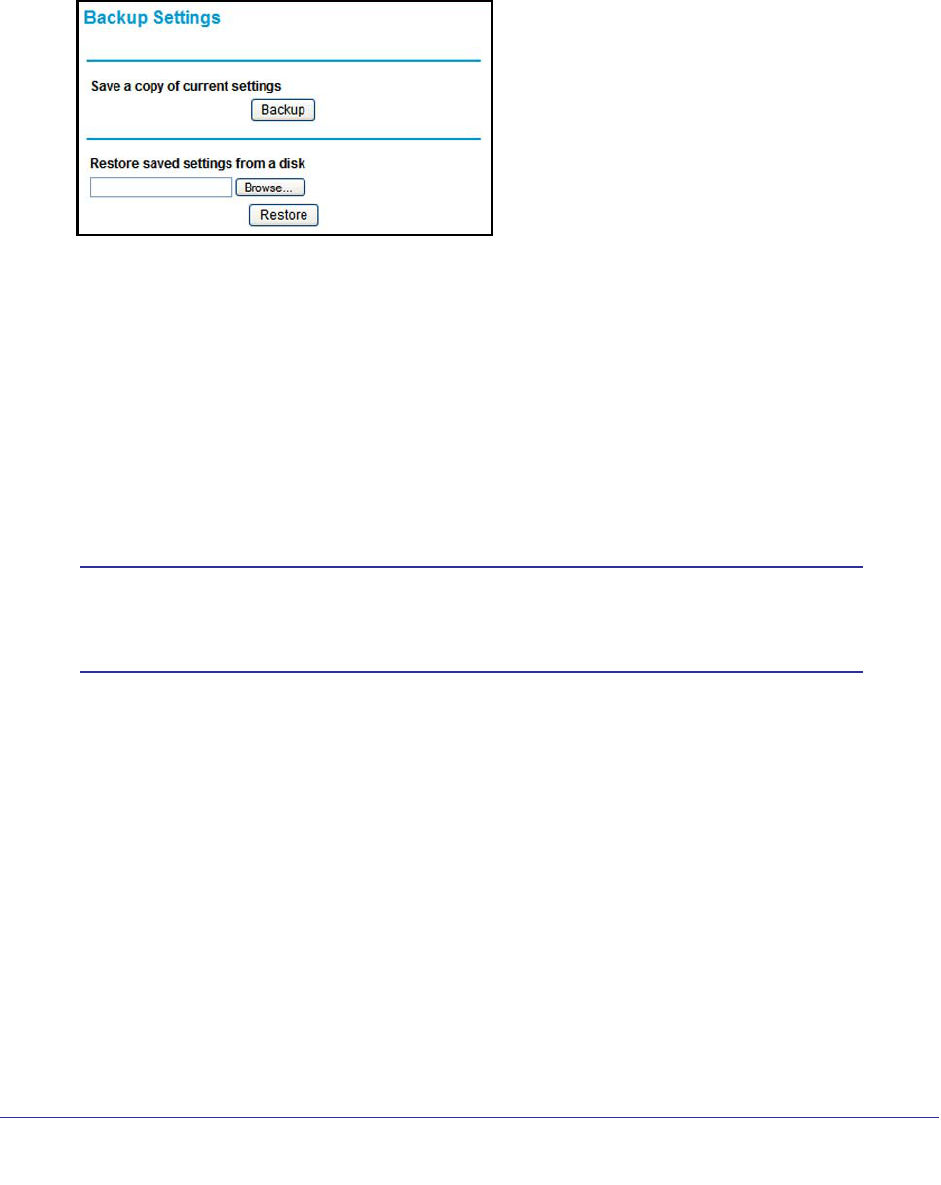
36 | Chapter 4. Managing Your Network
Wireless Cable Modem Gateway CG2003D User Manual
Back Up and Restore Your Settings
The configuration settings of the gateway are stored in a configuration file in the gateway. To
see the backup settings:
1. Select Maintenance > Backup Settings. The Backup Settings screen displays.
You can save a copy of the current configuration settings or restore the saved settings:
2. To save a copy of the current configuration settings, click Backup.
3. To restore the saved configuration settings from a backup file:
a. Click Browse.
b. Locate and select the previously saved backup file (by default, CG2003D.cfg).
c. Click Restore.
A message notifies you when the gateway has been restored to previous settings. Then,
the gateway restarts, which takes about one minute.
Note: When restoring configuration settings, do not interrupt the process
by going on online, turning off the gateway, or shutting down the
computer.
Event Log
The gateway logs security-related events such as denied incoming service requests and
hacker probes. To see the event log:

Chapter 4. Managing Your Network | 37
Wireless Cable Modem Gateway CG2003D User Manual
1. Select Maintenance > Event Log. The Event Log screen displays.
To clear the log, click Clear Log; to refresh the log, click Refresh. You can enable email
notification to receive these logs in an e-mail message. For information about email
notifications, see Logs on page 24.
Run the Diagnostic Ping Utility
You can use the Diagnostics screen to test connectivity to a PC using the ping command.
To start a ping test:
1. Select Maintenance > Diagnostics. The Diagnostics screen displays.
2. Under Ping Test Parameters, enter the following settings:
• Target. Enter the IP address of the computer that you would like to ping.
• Ping Size. Enter the size of the ping packet.

38 | Chapter 4. Managing Your Network
Wireless Cable Modem Gateway CG2003D User Manual
• No. of Pings. Enter the number of times you would like to ping the computer.
• Ping Interval. Enter the time you would like to wait between the pings.
3. Click Start Test.To stop the test while in progress, click Abort Test.
4. To see the results of the ping test, click REFRESH. To clear the test results after the test has
completed, click Clear Results.

Chapter 5. Advanced Settings | 39
5
5. Advanced Settings
This chapter describes how to customize your network through the advanced settings on your
Wireless Cable Modem Gateway. When you log in to the gateway, these tasks are grouped
under Advanced.
This chapter includes:
• Dynamic DNS on page 40
• Set Up a DMZ Host on page 41
• LAN IP Settings on page 41
• Set up Remote Management on page 43
• Universal Plug and Play (UPnP) on page 45
Note: For information about port forwarding and port blocking, see
Chapter 3, Content Filtering and Firewall Rules.
Log in to the gateway using its default address of http://192.168.0.1 or at whatever IP
address the unit is currently configured. Use the default user name of admin and default
password of password, or the password you have set up.
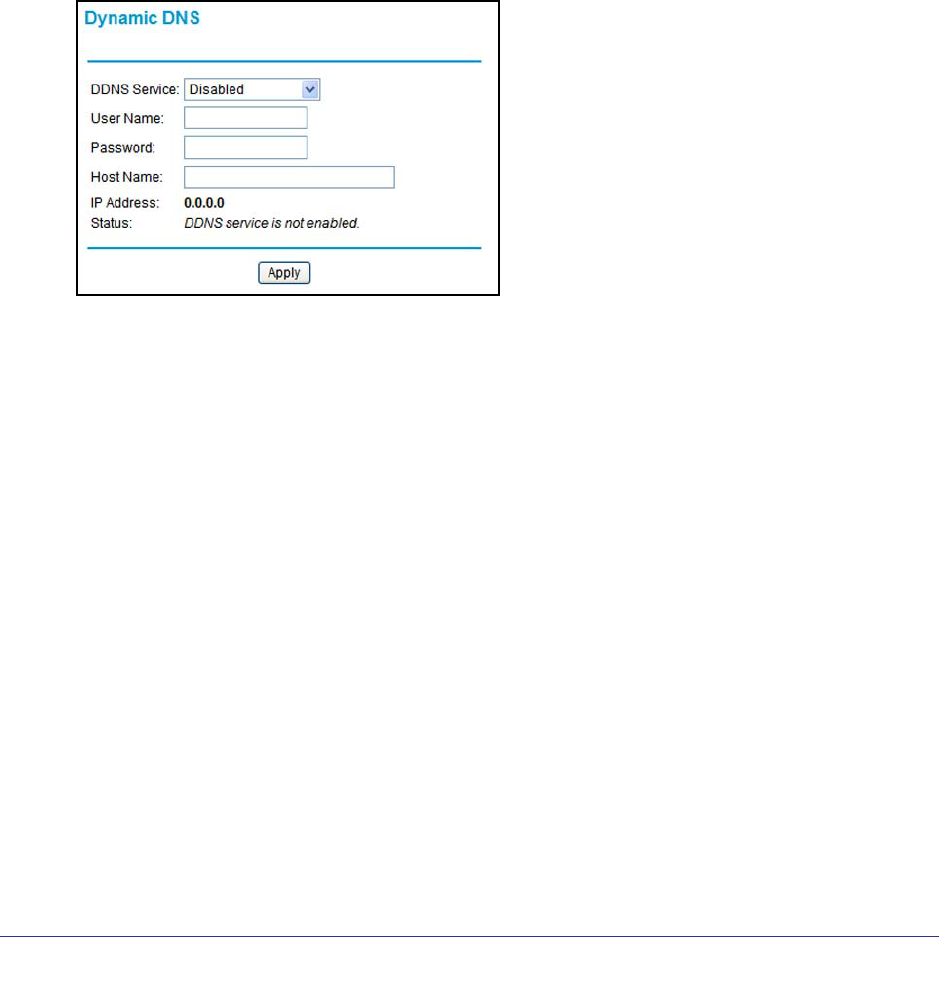
40 | Chapter 5. Advanced Settings
Wireless Cable Modem Gateway CG2003D User Manual
Dynamic DNS
A dynamic DNS service provides a central public database where information (such as e-mail
addresses, host names and IP addresses) can be stored and retrieved. The dynamic DNS
server also stores password-protected information and accepts queries based on e-mail
addresses.
If you want to use a dynamic DNS service, you have to register for it. The dynamic DNS client
service provider will give you a password or key.
To configure dynamic DNS:
1. Select Advanced > Dynamic DNS. The DDNS screen displays.
2. Select www.DynDNS.org in the DDNS Service drop-down list.
3. Enter the following information:
• User Name. Enter the user name for your dynamic DNS account.
• Password. Enter the password (or key) for your dynamic DNS account.
• Host Name. Enter the host same that your dynamic DNS service provider gave you.
(The DDNS service provider may call this the domain name.)
4. Click Apply to save your settings.
To disable dynamic DNS:
1. In the DDNS Service field, select Disabled.
2. Click Apply to save your settings.

Chapter 5. Advanced Settings | 41
Wireless Cable Modem Gateway CG2003D User Manual
Set Up a DMZ Host
You can use the DMZ Host screen to set the gateway to respond to a ping and specify a DMZ
address. To configure a default DMZ host:
1. Select Advanced > DMZ Host. The DMZ Host screen displays.
2. If you want the gateway to respond to a ping from the Internet, select the Respond to Ping
on WAN check box. Responding to pings can be useful in a diagnostic situation.
3. Complete the DMZ IP address in the DMZ Address field to designate a PC that is available
to anyone on the Internet for services that you have not defined. Because of security
concerns, only do this if you are willing to risk open access. If you do not assign a DMZ
address, the gateway discards any undefined service request.
4. Click Apply to save your settings.
LAN IP Settings
The LAN IP screen allows you to configure LAN IP services such as the IP address of the
Gateway and DHCP. The TCP/IP and DHCP default values work fine in most cases.

42 | Chapter 5. Advanced Settings
Wireless Cable Modem Gateway CG2003D User Manual
To view or change LAN IP settings:
1. Select Advanced > LAN IP. The LAN IP screen displays.
2. Enter the following LAN IP settings:
• LAN IP Address. Enter the LAN IP address that you would like to assign for your
gateway in dotted decimal notation. The factory default settings is 192.168.0.1.
• Subnet Mask. Enter the network number portion of an IP address. Unless you are
implementing subnetting, use 255.255.255.0 as the subnet mask.
• DHCP Server. The gateway is set up by default as a Dynamic Host Configuration
Protocol (DHCP) server, which provides the TCP/IP configuration for all the
computers that are connected to the gateway. You can change the default setting.
- Yes. Select this settings to enable the DHCP server on the gateway and assign IP
addresses to computers on your LAN automatically.
- No. Select this settings to assign IP addresses manually, or if you have another
DHCP server on your network.
If you disable the DHCP server, you will need to assign to your PC a static IP address
to reconnect to the gateway and enable the DHCP server again.
• Starting IP Address. Complete the first of the contiguous addresses in the IP
address pool. 192.168.0.10 is the default start address.
• Ending IP Address. Complete the last of the contiguous addresses in the IP address
pool. 192.168.0.19 is the default end address.
3. Click Apply to save your LAN IP settings.
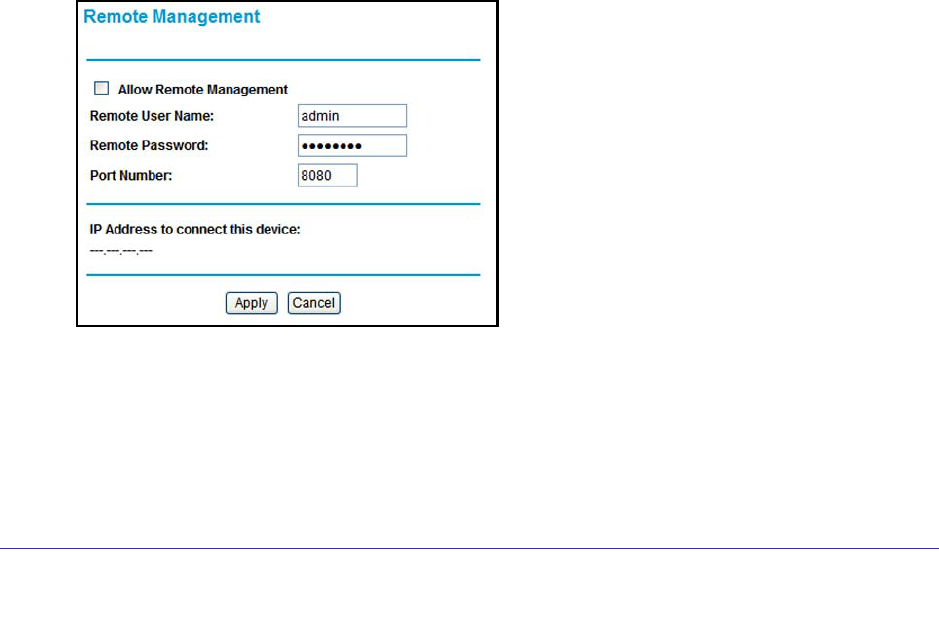
Chapter 5. Advanced Settings | 43
Wireless Cable Modem Gateway CG2003D User Manual
Reserve an IP Address for DHCP Use
To reserve an IP address for DHCP use, enter the DHCP server reservation settings for the
private LAN under DHCP Reservation Lease Info in the LAN IP screen:
1. Enter the MAC address of the PC for which you want to reserve an IP address.
2. Enter the permanent IP address for the PC.
3. Click Add to save your settings.
The MAC address and IP address are displayed in the DHCP Client Lease Info table. The
current system time is also displayed.
To delete an IP address from the DHCP Client Lease Info table:
1. In the DHCP Client Lease Info table, click the radio button for the MAC and IP address
that you want to remove.
2. Click Delete to remove the information for the selected MAC and IP address from the DHCP
Client Lease Info table.
To remove all information from the DHCP Client Lease Info table, click Clear DHCP Leases.
Set up Remote Management
With remote management, you can allow a user or users on the Internet to configure,
upgrade, and check the status of the gateway.
To set up the gateway for remote management:
1. Select Advanced > Remote Management. The Remote Management screen displays.
2. Select the Allow Remote Management check box.
3. Enter the following information:
• Remote Password. Enter the user name that will be used from the remote PC to
manage the gateway. This password is different from the password that you use to log
into the gateway from your LAN.

44 | Chapter 5. Advanced Settings
Wireless Cable Modem Gateway CG2003D User Manual
Be sure to change the gateway’s remote management password to a very secure
password before enabling remote management. The ideal password should contain
no dictionary words from any language, and should be a mixture of letters (both upper
and lower case), numbers, and symbols. Your password can be up to 16 characters.
• Port Number. Specify the port number that will be used for accessing the
management interface. The default port number is 80.
Web browser access normally uses the standard HTTP service port 80. For greater
security, you can change the remote management Web interface to a custom port by
entering that number in the box provided. Choose a number between 1024 and
65535, but do not use the number of any common service port. The default is 8080,
which is a common alternate for HTTP.
4. Click Apply to save your changes.
Remote Management After a Reset
If you would like to erase settings but continue to allow access from the WAN after the
settings have been erased, select the Allow Remote Management after Factory Default
Reset check box under “Revert to factory default settings” in the Remote Management
screen. Then, click Erase.
CAUTION:
Do not attempt to go online, turn off the gateway, shut down the computer,
or do anything else to the gateway until the gateway finishes restarting.
When the test light turns off, wait a few more seconds before you do
anything with the gateway.
After you have erased the gateway’s current settings, the gateway’s password is password,
the LAN IP address is 192.168.0.1, the gateway functions as a DHCP server on the LAN, and
as a DHCP client to the Internet.
URL to Connect to The Gateway
To manage the gateway via the Internet, you need its public IP address, as seen from the
Internet. This public IP address is allocated by your ISP, and is shown under “IP Address to
connect this device” in the Remote Management screen. Note that if your ISP account uses a
dynamic IP address instead of a fixed IP address, the address can change each time you
connect to your ISP. There are two solutions for this issue:
• Be sure that your ISP allocates a fixed IP address for the gateway.
• Use the Dynamic DNS feature so you can connect using a domain name, rather than an
IP address. See Dynamic DNS on page 40.

Chapter 5. Advanced Settings | 45
Wireless Cable Modem Gateway CG2003D User Manual
Universal Plug and Play (UPnP)
Universal Plug and Play (UPnP) helps devices, such as Internet appliances and computers,
access the network and connect to other devices as needed. UPnP devices can
automatically discover the services from other registered UPnP devices on the network.
To configure UPnP:
1. Select Advanced > UPnP. The UPnP screen displays.
2. Select the Turn UPnP On check box. The default setting is disabled, which prevents the
gateway from allowing a device to automatically control resources such as port forwarding.
3. Enter the following information:
• Advertisement Period. Enter how often the gateway broadcasts its UPnP
information. The default is 30 minutes.Shorter time periods mean that control points
have current device status at the expense of more network traffic. Longer time
periods reduce network traffic, but can result in less fresh device status.
• Advertisement Time to Live. Enter the time to live for the advertisement, which is
measured in hops (steps) for each UPnP packet that is sent. A hop is the number of
steps that are allowed to propagate for each UPnP advertisement before it
disappears. The number of hops can range from 1 to 255. The default value for the
advertisement time to live is 4 hops, which should be fine for most home networks. If
you notice that some devices are not being updated or reached correctly, you might
need to increase this value slightly.
The UPnP Portmap Table displays the IP address of each UPnP device that is currently
accessing the gateway and which internal and external ports of the gateway were opened
by that device. The UPnP Portmap Table also displays the protocol for the port that was
opened and if that port is still active for each IP address.
4. Perform one of the following actions:
• Click Apply to save your settings.
• Click Cancel to disregard any unsaved changes.
• Click Refresh to update the UPnP Portmap Table and to show the active ports that
are currently opened by UPnP devices.

Chapter 6. Troubleshooting | 46
6
6. Troubleshooting
This chapter gives information about troubleshooting your gateway.
Tip: NETGEAR provides helpful articles, documentation, and the latest
software updates at http://www.netgear.com/support.
This chapter includes:
• Using LEDs to Troubleshoot on page 47.
• Cannot Log in to the Gateway on page 48.
• Troubleshooting the Internet Connection on page 49.
• Back Up and Restore Your Settings on page 36.

Chapter 6. Troubleshooting | 47
Wireless Cable Modem Gateway CG2003D User Manual
Using LEDs to Troubleshoot
After you have turned on power to the gateway, you should do the following:
1. When power is first applied, verify that the Power LED is on.
2. Verify that the numbered Ethernet LEDs come on momentarily.
3. After a few seconds, verify that the Local port Link LEDs are lit for any local ports that are
connected.
The LEDs on the front panel indicate gateway activity and can be used for troubleshooting.
LEDs Stay Off When the Gateway Is Plugged in
• Make sure that the power cord is properly connected to your gateway and that the power
supply adapter is properly connected to a functioning power outlet.
• Check that you are using the 12VDC power adapter supplied by NETGEAR for this
product.
• If the error persists, you have a hardware problem and should contact technical support.
All LEDs Stay On
• Clear the Gateway’s configuration to factory defaults. This will set the Gateway’s IP
address to 192.168.0.1. See Back Up and Restore Your Settings on page 36.
• If the error persists, you might have a hardware problem and should contact technical
support.
LAN LED Stays Off
If a LAN LED is off for a port with an Ethernet connection, check the following:
• Make sure that the Ethernet cable connections are secure at the Gateway and at the hub
or PC.
• Make sure that power is turned on to the connected hub or PC.
• Be sure you are using the correct cable.
Cable Link LED Is Off and the Gateway is Cabled to the Wall Jack
• Make sure that the coaxial cable connections are secure at the gateway and at the wall
jack.
• Make sure that your cable Internet service has been provisioned by your cable service
provider. Your provider should verify that the signal quality is good enough for cable
modem service.
• Remove any excessive splitters you have on your cable line. It might be necessary to run
a “home run” back to the point where the cable enters your home.

48 | Chapter 6. Troubleshooting
Wireless Cable Modem Gateway CG2003D User Manual
Cannot Log in to the Gateway
If you are unable to access the gateway’s main menu from a computer on your local network,
check the following:
• Check the Ethernet connection between the computer and the Gateway as described in
the previous section.
• Make sure that your PC’s IP address is on the same subnet as the Gateway. If you are
using the recommended addressing scheme, your PC’s address should be in the range of
192.168.0.10 to 192.168.0.254. Refer to the link to the online document ITCP/IP
Networking Basics in Appendix B for help configuring your computer.
Note: If your PC’s IP address is shown as 169.254.x.x:
Recent versions of Windows and MacOS will generate and assign
an IP address if the computer cannot reach a DHCP server. These
auto-generated addresses are in the range of 169.254.x.x. If your IP
address is in this range, check the connection from the PC to the
gateway and reboot your PC.
• If your gateway’s IP address has been changed and you don’t know the current IP
address, clear the gateway’s configuration to factory defaults. This will set the Gateway’s
IP address to 192.168.0.1. This procedure is explained in Set up Remote Management
on page 43.
• Make sure your browser has Java, JavaScript, or ActiveX enabled. If you are using
Internet Explorer, click Refresh to make sure that the Java applet is loaded.
• Try quitting the browser and launching it again.
• Make sure you are using the correct login information. The gateway has two user names
both lower-case (Caps Lock should be off):
-The superuser login name is MSO with the default password of changeme.
-The other login name is admin with the default password of password.
If the Gateway does not save changes you have made, check the following:
• When entering configuration settings, be sure to click the Apply button before moving to
another screen, or your changes are lost.
• Click the Refresh or Reload button in the Web browser. The changes may have occurred,
but the Web browser may be caching the old configuration.

Chapter 6. Troubleshooting | 49
Wireless Cable Modem Gateway CG2003D User Manual
Troubleshooting the Internet Connection
If your gateway is unable to access the Internet and your Cable Link LED is on, you may
need to register the Cable MAC Address and/or Device MAC Address of you gateway with
your cable service provider. This is described in Cabling the Gateway on page 8.
Additionally, your PC may not have the Gateway configured as its TCP/IP gateway. If your
PC obtains its information from the Gateway by DHCP, reboot the PC and verify the gateway
address. See the link to the online document ITCP/IP Networking Basics in Appendix B.
Troubleshooting a TCP/IP Network Using a Ping Utility
Most TCP/IP terminal devices and routers contain a ping utility that sends an echo request
packet to the designated device. The device then responds with an echo reply.
Troubleshooting a TCP/IP network is made easier by using the ping utility in your PC or
workstation.
Test the LAN Path to Your Gateway
You can use ping to verify that the LAN path to your Gateway is set up correctly.
To ping the gateway from a PC running Windows 95 or later:
1. From the Windows toolbar, click on the Start button and select Run.
2. In the field provided, type Ping followed by the IP address of the gateway, as in this
example:
ping 192.168.0.1
3. Click OK.
You should see a message like this one:
Pinging <IP address> with 32 bytes of data
If the path is working, you see this message:
Reply from < IP address >: bytes=32 time=NN ms TTL=xxx
If the path is not working, you see this message:
Request timed out
If the path is not working correctly, you could have one of the following problems:
• Wrong physical connections.
- Make sure the LAN port LED is on. If the LED is off, see The LEDs on the front
panel indicate gateway activity and can be used for troubleshooting. on page 47.
- Check that the corresponding Link LEDs are on for your network interface card
and for the hub ports (if any) that are connected to your workstation and Gateway.
• Wrong network configuration.

50 | Chapter 6. Troubleshooting
Wireless Cable Modem Gateway CG2003D User Manual
- Verify that the Ethernet card driver software and TCP/IP software are both
installed and configured on your PC or workstation.
- Verify that the IP address for your Gateway and your workstation are correct and
that the addresses are on the same subnet.
Test the Path from Your PC to a Remote Device
After verifying that the LAN path works correctly, test the path from your PC to a remote
device. From the Windows run menu, type:
PING -n 10 <IP address>
where <IP address> is the IP address of a remote device such as your ISP’s DNS server.
If the path is functioning correctly, replies as in the previous section are displayed. If you do
not receive replies:
• Check that your PC has the IP address of your gateway listed as the default gateway. If
the IP configuration of your PC is assigned by DHCP, this information will not be visible in
your PC’s Network Control Panel. Verify that the IP address of the Gateway is listed as
the default gateway. See the link to the online document ITCP/IP Networking Basics in
Appendix B.
• Check to see that the network address of your PC (the portion of the IP address specified
by the netmask) is different from the network address of the remote device.
• Check that your Cable Link LED is on.
• If your ISP assigned a host name to your PC, enter that host name as the Account Name
in the Basic Settings menu.

Appendix A. Technical Specifications and Factory Default Settings | 51
A
A. Technical Specifications and Factory
Default Settings
This appendix provides technical specifications and default factory settings for the gateway.
Technical Specifications
Table 1. Technical Specifications
Specification Description
Network Protocol and Standards Compatibility
Data and routing protocols • TCP/IP
• DHCP server and client
• DNS relay
• NAT (many-to-one)
• TFTP client
• VPN pass through (IPSec, PPTP)
Power Adapter • North America (input): 120V, 60 Hz, input
• All regions (output): 12 V DC @ 1A output, 12W maximum
Physical Specifications • Dimensions: 175 by 114 by 30 mm (6.9 by 4.5 by 1.2 in.)
• Weight: 0.31 kg (0.68 lb)
Environmental Specifications • Operating temperature: 32°-140° F (0° to 40° C)
• Operating humidity: 90% maximum relative humidity,
noncondensing.
Electromagnetic Emissions Meets requirements of FCC Part 15 Class B
Interface Specifications
LAN 10BASE-T or 100BASE-Tx, RJ-45
802.11g and 802.11b Wireless Access Point
WAN DOCSIS 2.0. Downward compatible with DOCSIS 1.0 and
DOCSIS 1.1.

52 | Appendix A. Technical Specifications and Factory Default Settings
Wireless Cable Modem Gateway CG2003D User Manual
Factory Default Settings
You can use the Restore Factory Settings located on the bottom of your gateway to reset all
settings to their factory defaults.
This is called a hard reset. To perform a hard reset, push and hold the reset button for 5
seconds. The gateway reboots and returns to the settings shown in the following table.
Wireless
Radio data rates 1, 2, 5.5, 6, 9, 12, 18, 24, 36, 48, 54, and 108 Mbps
Auto Rate Sensing
Frequency 2.4-2.5 GHz
Operating frequency ranges 2.412~2.462 GHz (US)
2.412~2.472 GHz (Japan)
2.412~2.472 GHz (Europe ETSI)
Encryption 40-bit (also called 64-bit), 128-bit WEP data encryption,
WPA-PSK(TKIP), and WPA2-PSK(AES)
Table 2. Default Configuration Settings
Feature Default Behavior
Gateway Login
User login URL http://192.168.1.1
User names and passwords (case
sensitive)
• MSO/changme
• admin/password
Local Network (LAN)
LAN IP 192.168.0.1
Subnet mask 255.255.255.0
DHCP server Enabled
DHCP starting IP address 192.168.0.10
DHCP Ending IP address 192.168.0.19
Firewall
Inbound communication from the Internet Disabled (except traffic on port 80, the http port)
Outbound communication to the Internet Enabled (all)
Source MAC filtering Disabled
Table 1. Technical Specifications (Continued)
Specification Description

Appendix A. Technical Specifications and Factory Default Settings | 53
Wireless Cable Modem Gateway CG2003D User Manual
Internet Connection
WAN MAC address Use default hardware address
WAN MTU size 1500
Wireless
Wireless communication Enabled
SSID name Wireless
Security WEP (Wired Equivalent Privacy) 128-bit encryption
Broadcast SSID Enabled
Transmission speed Autoa
Country/region United States (varies by region)
RF channel 6
Operating mode g and b
Data rate Best
Output power Full
Access point Enabled
Authentication type Open System
Wireless card access list All wireless stations allowed
a. Maximum Wireless signal rate derived from IEEE Standard 802.11 specifications. Actual throughput will vary. Network conditions and
environmental factors, including volume of network traffic, building materials and construction, and network overhead, lower actual data
throughput rate.
Table 2. Default Configuration Settings (Continued)
Feature Default Behavior

Appendix B. Related Documents | 54
B
B. Related Documents
This appendix provides links to reference documents you can use to gain a more complete
understanding of the technologies used in your NETGEAR product.
Table 1.
Document Link
Using Microsoft Vista and
Windows XP to Manage
Wireless Network Connections
http://documentation.netgear.com/reference/enu/winzerocfg/index.htm
ITCP/IP Networking Basics http://documentation.netgear.com/reference/enu/tcpip/index.htm
Wireless Networking Basics http://documentation.netgear.com/reference/enu/wireless/index.htm
Preparing Your Network http://documentation.netgear.com/reference/enu/wsdhcp/index.htm
Virtual Private Networking Basics http://documentation.netgear.com/reference/enu/vpn/index.htm
Glossary http://documentation.netgear.com/reference/enu/glossary/index.htm

Appendix B. Related Documents | 55
Wireless Cable Modem Gateway CG2003D User Manual

Appendix C. Notification of Compliance | 56
C
C. Notification of Compliance
NETGEAR Wireless Routers, Gateways, APs
Regulatory Compliance Information
This section includes user requirements for operating this product in accordance with National laws for usage of radio
spectrum and operation of radio devices. Failure of the end-user to comply with the applicable requirements may
result in unlawful operation and adverse action against the end-user by the applicable National regulatory authority.
Note: This product’s firmware limits operation to only the channels allowed in a particular Region or Country.
Therefore, all options described in this user's guide may not be available in your version of the product.
FCC Requirements for Operation in the United States
FCC Information to User
This product does not contain any user serviceable components and is to be used with approved antennas only.
Any product changes or modifications will invalidate all applicable regulatory certifications and approvals
FCC Guidelines for Human Exposure
This equipment complies with FCC radiation exposure limits set forth for an uncontrolled environment. This
equipment should be installed and operated with minimum distance of 20 cm between the radiator and your body.
This transmitter must not be co-located or operating in conjunction with any other antenna or transmitter.
FCC Declaration of Conformity
We, NETGEAR, Inc., 350 East Plumeria Drive, San Jose, CA 95134, declare under our sole responsibility that the
Wireless Cable Modem Gateway CG2003D complies with Part 15 Subpart B of FCC CFR47 Rules. Operation is
subject to the following two conditions:
• This device may not cause harmful interference, and
• This device must accept any interference received, including interference that may cause undesired operation.
FCC Radio Frequency Interference Warnings & Instructions
This equipment has been tested and found to comply with the limits for a Class B digital device, pursuant to Part 15
of the FCC Rules. These limits are designed to provide reasonable protection against harmful interference in a
residential installation. This equipment uses and can radiate radio frequency energy and, if not installed and used in
accordance with the instructions, may cause harmful interference to radio communications. However, there is no
guarantee that interference will not occur in a particular installation. If this equipment does cause harmful
interference to radio or television reception, which can be determined by turning the equipment off and on, the user
is encouraged to try to correct the interference by one or more of the following methods:
• Reorient or relocate the receiving antenna.
• Increase the separation between the equipment and the receiver.
• Connect the equipment into an electrical outlet on a circuit different from that which the radio receiver is
connected.
• Consult the dealer or an experienced radio/TV technician for help.

Appendix C. Notification of Compliance | 57
Wireless Cable Modem Gateway CG2003D User Manual
FCC Caution
• Any changes or modifications not expressly approved by the party responsible for compliance could void the
user’s authority to operate this equipment.
• This device complies with Part 15 of the FCC Rules. Operation is subject to the following two conditions: (1) This
device may not cause harmful interference, and (2) this device must accept any interference received, including
interference that may cause undesired operation.
• For product available in the USA market, only channel 1~11 can be operated. Selection of other channels is not
possible.
• This device and its antenna(s) must not be co-located or operation in conjunction with any other antenna or
transmitter.
FCC Radiation Exposure Statement:
This equipment complies with FCC radiation exposure limits set forth for an uncontrolled environment. This
equipment should be installed and operated with minimum distance 20cm between the radiator & your body.
This transmitter must not be co-located or operating in conjunction with any other antenna or transmitter.
The availability of some specific channels and/or operational frequency bands are country dependent and are
firmware programmed at the factory to match the intended destination. The firmware setting is not accessible by the
end user.
Canadian Department of Communications Radio Interference Regulations
This digital apparatus, Wireless Cable Modem Gateway CG2003D, does not exceed the Class B limits for radio-noise
emissions from digital apparatus as set out in the Radio Interference Regulations of the Canadian Department of
Communications.
Industry Canada statement:
This device complies with RSS-210 of the Industry Canada Rules. Operation is subject to the following two
conditions:
(1) This device may not cause harmful interference, and (2) this device must accept any interference received,
including interference that may cause undesired operation.
Radiation Exposure Statement:
This equipment complies with Canada radiation exposure limits set forth for an uncontrolled environment. This
equipment should be installed and operated with minimum distance 20cm between the radiator & your body.
This device has been designed to operate with an antenna having a maximum gain of 5.59 dB. Antenna having a
higher gain is strictly prohibited per regulations of Industry Canada. The required antenna impedance is 50 ohms.
Europe – EU Declaration of Conformity
Marking with the above symbol indicates compliance with the Essential Requirements of the R&TTE Directive of the
European Union (1999/5/EC).
This equipment meets the following conformance standards:
• EN300 328 (2.4Ghz), EN301 489-17, EN301 893 (5Ghz), EN60950-1
• This device is a 2.4 GHz wideband transmission system (transceiver), intended for use in all EU member states and
EFTA countries, except in France and Italy where restrictive use applies.
• In Italy, the end-user should apply for a license at the national spectrum authorities in order to obtain authorization to
use the device for setting up outdoor radio links and/or for supplying public access to telecommunications and/or
network services.

58 | Appendix C. Notification of Compliance
Wireless Cable Modem Gateway CG2003D User Manual
• This device may not be used for setting up outdoor radio links in France, and in some areas the RF output power
may be limited to 10 mW EIRP in the frequency range of 2454 – 2483.5 MHz. For detailed information contact the
national spectrum authority in France.
For complete DoC, visit the NETGEAR EU Declarations of Conformity website at::
http://kb.netgear.com/app/answers/detail/a_id/11621/
Table 2. EDOC in Languages of the European Community
Language Statement
Cesky [Czech] NETGEAR Inc. tímto prohlašuje, že tento Radiolan je ve shode se
základními požadavky a dalšími príslušnými ustanoveními smernice
1999/5/ES.
Dansk [Danish] Undertegnede NETGEAR Inc. erklærer herved, at følgende udstyr
Radiolan overholder de væsentlige krav og øvrige relevante krav i
direktiv 1999/5/EF.
Deutsch [German] Hiermit erklärt NETGEAR Inc., dass sich das Gerät Radiolan in
Übereinstimmung mit den grundlegenden Anforderungen und den
übrigen einschlägigen Bestimmungen der Richtlinie 1999/5/EG
befindet.
Eesti [Estonian] Käesolevaga kinnitab NETGEAR Inc. seadme Radiolan vastavust
direktiivi 1999/5/EÜ põhinõuetele ja nimetatud direktiivist tulenevatele
teistele asjakohastele sätetele.
English Hereby, NETGEAR Inc., declares that this Radiolan is in compliance
with the essential requirements and other relevant provisions of
Directive 1999/5/EC.
Español [Spanish] Por medio de la presente NETGEAR Inc. declara que el Radiolan cumple con los
requisitos esenciales y cualesquiera otras disposiciones aplicables o exigibles de la
Directiva 1999/5/CE.
Ελληνική [Greek] ΜΕ ΤΗΝ ΠΑΡΟΥΣΑ NETGEAR Inc. ΔΗΛΩΝΕΙ ΟΤΙ Radiolan ΣΥΜΜΟΡΦΩΝΕΤΑΙ
ΠΡΟΣ ΤΙΣ ΟΥΣΙΩΔΕΙΣ ΑΠΑΙΤΗΣΕΙΣ ΚΑΙ ΤΙΣ ΛΟΙΠΕΣ ΣΧΕΤΙΚΕΣ ΔΙΑΤΑΞΕΙΣ ΤΗΣ
ΟΔΗΓΙΑΣ 1999/5/ΕΚ.
Français [French] Par la présente NETGEAR Inc. déclare que l'appareil Radiolan est
conforme aux exigences essentielles et aux autres dispositions
pertinentes de la directive 1999/5/CE.
Italiano [Italian] Con la presente NETGEAR Inc. dichiara che questo Radiolan è
conforme ai requisiti essenziali ed alle altre disposizioni pertinenti
stabilite dalla direttiva 1999/5/CE.
Latviski [Latvian] Ar šo NETGEAR Inc. deklarē, ka Radiolan atbilst Direktīvas
1999/5/EK būtiskajām prasībām un citiem ar to saistītajiem
noteikumiem.
Lietuvių [Lithuanian] Šiuo NETGEAR Inc. deklaruoja, kad šis Radiolan atitinka esminius
reikalavimus ir kitas 1999/5/EB Direktyvos nuostatas.
Nederlands [Dutch] Hierbij verklaart NETGEAR Inc. dat het toestel Radiolan in
overeenstemming is met de essentiële eisen en de andere relevante
bepalingen van richtlijn 1999/5/EG.

Appendix C. Notification of Compliance | 59
Wireless Cable Modem Gateway CG2003D User Manual
Interference Reduction Table
The table below shows the Recommended Minimum Distance between NETGEAR equipment and household
appliances to reduce interference (in feet and meters).
Household Appliance Recommended Minimum Distance
(in feet and meters)
Microwave ovens 30 feet / 9 meters
Baby Monitor - Analog 20 feet / 6 meters
Baby Monitor - Digital 40 feet / 12 meters
Cordless phone - Analog 20 feet / 6 meters
Cordless phone - Digital 30 feet / 9 meters
Bluetooth devices 20 feet / 6 meters
ZigBee 20 feet / 6 meters
Malti [Maltese] Hawnhekk, NETGEAR Inc., jiddikjara li dan Radiolan jikkonforma
mal-htigijiet essenzjali u ma provvedimenti ohrajn relevanti li hemm
fid-Dirrettiva 1999/5/EC.
Magyar [Hungarian Alulírott, NETGEAR Inc. nyilatkozom, hogy a Radiolan megfelel a
vonatkozó alapvetõ követelményeknek és az 1999/5/EC irányelv
egyéb elõírásainak.
Polski [Polish] Niniejszym NETGEAR Inc. oświadcza, że Radiolan jest zgodny z
zasadniczymi wymogami oraz pozostałymi stosownymi
postanowieniami Dyrektywy 1999/5/EC.
Português [Portuguese] NETGEAR Inc. declara que este Radiolan está conforme com os
requisitos essenciais e outras disposições da Directiva 1999/5/CE.
Slovensko [Slovenian] NETGEAR Inc. izjavlja, da je ta Radiolan v skladu z bistvenimi
zahtevami in ostalimi relevantnimi določili direktive 1999/5/ES.
Slovensky [Slovak] NETGEAR Inc. týmto vyhlasuje, že Radiolan spĺňa základné
požiadavky a všetky príslušné ustanovenia Smernice 1999/5/ES.
Suomi [Finnish] NETGEAR Inc. vakuuttaa täten että Radiolan tyyppinen laite on
direktiivin 1999/5/EY oleellisten vaatimusten ja sitä koskevien
direktiivin muiden ehtojen mukainen.
Svenska [Swedish] Härmed intygar NETGEAR Inc. att denna Radiolan står I
överensstämmelse med de väsentliga egenskapskrav och övriga
relevanta bestämmelser som framgår av direktiv 1999/5/EG.
Íslenska [Icelandic] Hér með lýsir NETGEAR Inc. yfir því að Radiolan er í samræmi við
grunnkröfur og aðrar kröfur, sem gerðar eru í tilskipun 1999/5/EC.
Norsk [Norwegian] NETGEAR Inc. erklærer herved at utstyret Radiolan er i samsvar med
de grunnleggende krav og øvrige relevante krav i direktiv 1999/5/EF.
Table 2. EDOC in Languages of the European Community
Language Statement

Index | 60
Index
A
adapter, wireless 11
B
backing up the configuration file 36
blocking
ports 27
services 26
blocking keywords, examples 25
C
cable channel 34
cable line splitter 8
cable network settings 10
coaxial cable 8
compliance 56
configuration
backup 36
erasing 36
factory default 35, 44
connected wireless devices
adding to 17
list of 17
D
Denial of Service (DoS) 24
devices, adding 13
DHCP
reserved IP address 43
server 42
diagnostics 37
disable SSID 12
disabling
SSID broadcast 12
DMZ host 41
DNS
dynamic service 40
E
e-mailing logs 24
Erase configuration 36
Ethernet cable 8
F
factory default settings 35, 44, 52
factory settings
resetting 7
firewall rules 27
front panel 6
G
gateway
backup 36
diagnostics 37
event log 36
factory default settings 35, 44, 52
main menu 48
password 34
remote management 43
status 33
technical specifications 51
guest networks 20
I
IP addresses, auto-generated 48
K
keywords
blocking 25
L
L2TP
connection 10
label, product 7
LAN
IP address 42
IP settings 41
LEDs
description 6

Index | 61
Wireless Cable Modem Gateway CG2003D User Manual
M
MAC address
location of 17
restrict access based on MAC address 16
MAC address, product label 7
MAC addresses
described 12
restricting access by 19
N
networks
guest 20
O
outbound rules 26, 27
P
package contents 5
passphrase, product label 7
passphrases 19
changing 18
password 34
passwords, see passphrases
ping utility 49
port blocking 26, 27
port forwarding 27, 30
port triggering 30
preset security
passphrase 18
R
rear panel 7
remote management 43
reset button 52
restricting wireless access by MAC addresses 19
router log 24
rules
inbound 27
outbound 26, 27
S
security 12
see also security options
security features 12
security options
described 12
settings 12
security PIN 7, 14
serial number, product label 7
sites, blocking 25
SSID
described 16
disable 12
SSID, product label 7
T
TCP/IP
network, troubleshooting 49
technical specifications 51
technical support 2
trademarks 2
troubleshooting 46
ISP connection 49
ping utility 49
TCP/IP network 49
U
Universal Plug and Play (UPnP) 45
USB
cable 8
W
Wi-Fi multimedia 21
Wi-Fi Protected Setup (WPS) 13, 14
adding devices 13
Wired Equivalent Privacy (WEP) encryption 19
passphrase 19
wireless
guest network 20
manually configuring settings 14
multimedia 21
wireless access points 16
wireless adapter 11
wireless channel 16
wireless network name 7
wireless network settings 16
wireless region 16
wireless security options 12
Wireless Settings screen 14
wireless settings, SSID broadcast 16
WPS button 13